Everything You Can Do with Market Research Online Surveys
Everything You Can Do with Market Research Online Surveys
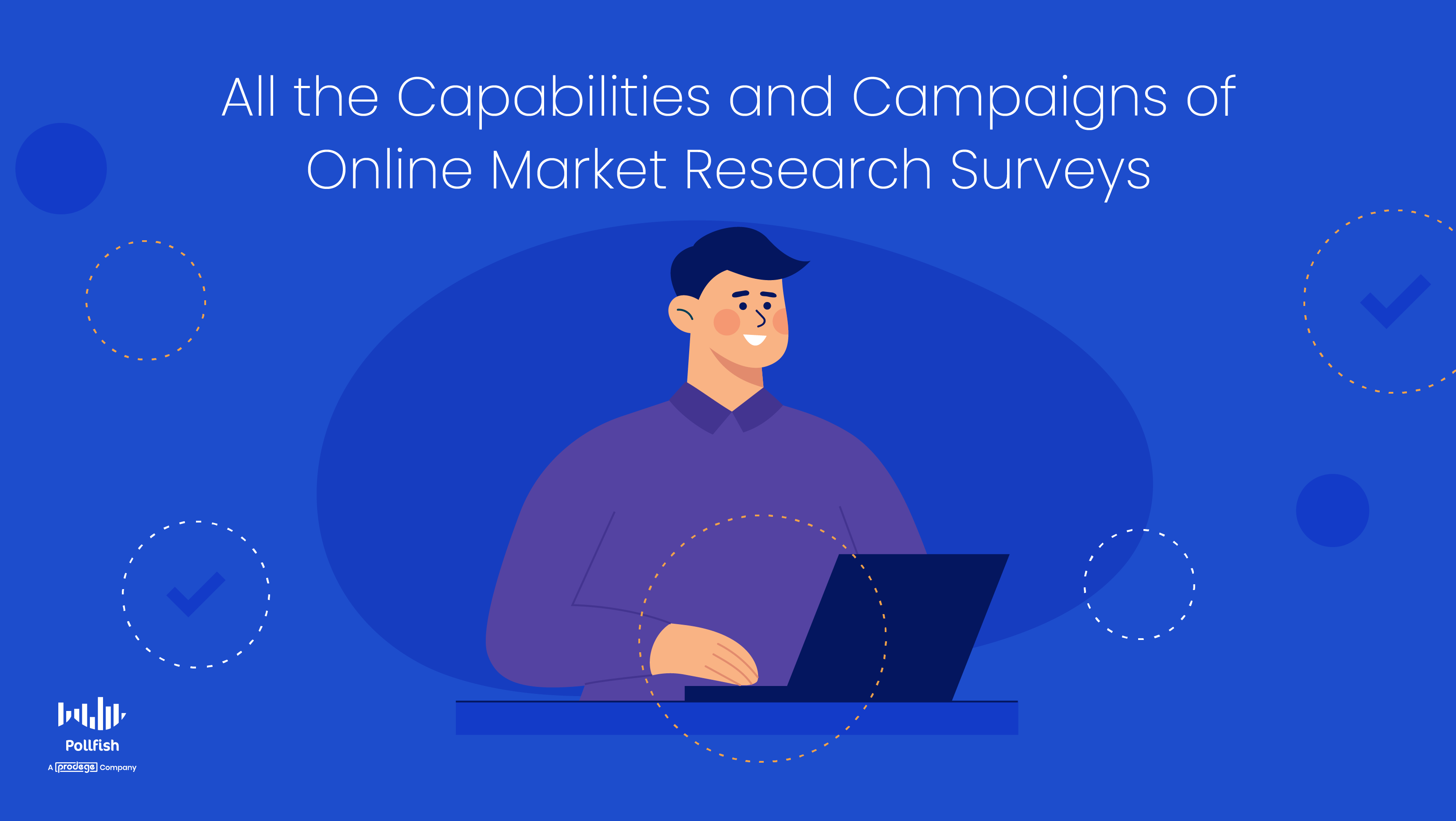
If you’ve ever begged the question, what can you do with market research online surveys? — we’ve got but one key response:
More like, what can’t you do with online market research surveys?
These digital tools gain you a wide range of insights into virtually anything about your target market or any target audience you intend to study.
You can apply them to any research project, as they grant you data on past campaigns (think existing ads, products or service sessions), as well as prepare you before you take any new action for your business.
Given that market research surveys have so many purposes, survey data remains important for both small and large businesses.
It is thus hardly surprising that the market research industry has grown 3.6% per year between 2017 and 2022 in the US on average. After all, it wouldn’t grow if businesses stopped relying on it.
This article gives you a deep dive into market research online surveys, what they entail, their importance and all of their applications.
Understanding Market Research Online Surveys
An online market research survey is both a major method and tool for conducting market research, which is the practice of studying your target market, the group of customers most likely to buy from your business.
Market research entails researching your target market and other customer segments in full depth, thereby understanding who they are, their needs, desires, preferences, aversions and more.
There are various forms of research, such as scientific, medical, socioeconomic, etc. A market research survey is a tool designed specifically for conducting market research, as its name suggests.
As such, it should include all the features necessary for researchers to learn what’s driving customer sentiment, market demand and a slew of other customer concerns.
An online market research survey is the modern form of a market research survey and market research at large. That’s because it is conducted online in an automated way, completes all quotas and grants you the swiftest and most accurate way to pull customer data.
Unlike other forms of conducting market research, online surveys allow you to get to the heart of the matter on virtually any topic. But there’s much more they can do, provided you use a strong survey platform.
When it comes to these surveys, the possibilities are endless.
What You Can Do with a Market Research Online Survey Platform
Most online market research surveys are conducted through an online survey platform. Such a platform allows researchers to partake in every part of the survey process.
However, keep in mind that all survey platforms are built differently, with different features and levels of respondent outreach.
The following outlines what you can do with an online survey platform:
- Target your respondents.
- Set all respondent qualifications.
- Create screening questions to further determine eligibility.
- Set quotas, the number of completed surveys and multiple audiences per survey.
- Create the survey questions, i.e., the questionnaire.
- Offer a variety of survey templates to align with various market research campaigns.
- Create disclaimers, introductions and thank you pages.
- Allow you to use a variety of question types.
- Send your survey to a vast network of digital publishers randomly.
- Allow you to send your survey to specific digital spaces and people.
In all, an online survey platform allows you to create and administer surveys, thus also working as a survey distribution service.
A powerful survey platform enables your online survey to perform a variety of tasks, which we cover further down this article. But first, let’s learn about the importance of these surveys.
The Importance of Market Research Online Surveys
Given all that we’ve already discussed that these surveys are capable of, you’ve probably caught on to their importance.
However, there are so many other reasons why market research online surveys are a must for your business, regardless of its stage, its brand reputation and other factors.
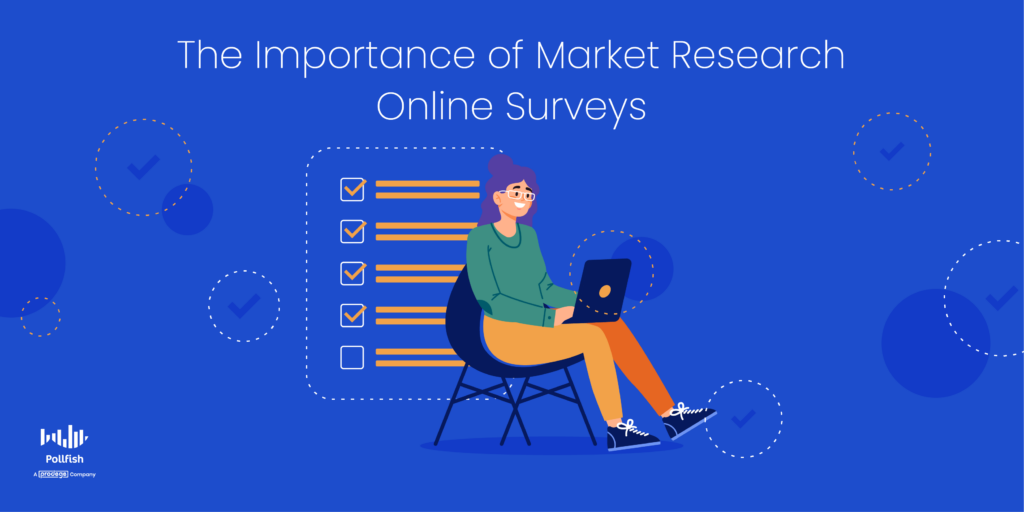
Firstly, these surveys form a critical aspect of your business strategy. This involves strategizing all things business-related, from understanding the reception to a new product, to how a support session was perceived.
With this knowledge in tow, you’ll be informed on how to make further business decisions and run different campaigns. Thus, you’ll be less likely to make major mistakes that will affect your bottom line, while delighting your customers.
Online market research surveys allow you to remain competitive, no matter how many players are in your industry, and how big (or small) your market share is. In fact, conducting these surveys is the answer to how to increase market share, as it helps you carry out productive campaigns.
These surveys are not just tools for gathering data, instead, they are also data visualizers, presenting your data in a variety of formats. This is especially important when you need to analyze survey data and use it to create a report, a whitepaper or any other type of research asset.
As data visualization tools, they also reduce and organize large amounts of information allowing you to easily compare two or more sets of data. This will depend on the data filtering capabilities of your online survey.
In addition, these surveys also allow you to uncover things not only in relation to your customers but your own business. You’ll therefore be able to learn things you would never have otherwise without this survey type.
That’s because this survey allows you to understand exactly how your customer base views your brand, how often they think about it, what they’d like to improve, what they dislike and so much more.
By understanding your customers in great depth, you won’t simply form better marketing, advertising and other business campaigns. You’ll also build stronger relationships with your customers, which fosters consumer loyalty.
Loyalty is the bedrock of customer retention, which is more important than customer acquisition. There are many reasons behind this, including the fact that the chances of converting existing customers are 60 -70%. The probability of converting a new customer is only 5- 20%.
Thus, by studying your customers with this survey, you’ll be able to understand them well, thus better appealing and catering to customers, strengthening your relationship. In turn, you’re building loyalty, allowing you to increase your customer retention rate.
Market research online surveys don’t merely allow you to understand how customers view your business, but your competitors as well. In this way, you can obtain all the competitive research you need simply by conducting such a survey.
All in all, these surveys are extremely important for all business affairs, as they help measure the representativeness of customer views and needs. The intelligence you gain from them allows you to make crucial decisions.
What You Can Study with Market Research Online Surveys
As mentioned, there are a myriad of things you can study with these surveys. As such, you can apply them to specific areas of business, including specific campaigns and macro applications.
As such, here we lay out several main purposes of conducting online market research surveys. As you can see, these are high-level and have many sub-methods and applications.
- General Marketing: Marketing involves all the activities performed to aid a business sell its products/services, which includes educating customers, interacting with them and more. Marketing market research exists to help businesses gauge their campaign efficacy and better understand how their customers view various campaigns.
- Advertising: Used to deploy sponsored messages to grow demand and elicit purchases, advertising, you can leverage it to influence customer behavior. This involves prompting existing customers to make more purchases or to gain new customers. Surveys can be used to determine which advertising messages are the most resonant and which ads elicit the most interest. You can ask questions to compare ads and their different parts.
- Branding: This discipline involves creating a reputation, an image and a set of associations around a brand. Branding market research helps brands differentiate themselves from one another and form a style unique to a company. Businesses can tie these surveys to branding by using them to test new logos, slogans, value propositions, content ideas and more.
- Market Segmentation: Market segmentation is a macro-application that refers to dividing a target market into smaller segments and assigning certain values to each segment to better understand all your customers. That’s because a target market includes all the customers most likely to buy from a particular business and is not solely defined by one group. Researchers can create questions about their target market’s habits, lifestyles, preferences and more to distill them into several segments. From there, marketers can adopt different marketing campaigns for each segment.
- PR: Public Relations, or PR, as it is commonly referred to, aims to control the distribution and spread of information about a company (or individual) and the public. Its goal is to control the narrative of a business or organization to gain positive public perception. These surveys can help by asking questions on how well respondents know a business and their general thoughts on its operations, products, experiences, performance, etc. Researchers can also test out press release ideas and pitches through these surveys.
- Brand Tracking: Brand tracking refers to continuously measuring or tracking, as its name suggests, your brand's health. This involves analyzing how your customers buy and use your products and what they think and feel about the brand itself. These sentiments are subject to change, especially when things change at a business, whether they have a new ad campaign, have been acquired or are offering new products. You can keep watch of this with these surveys.

- Brand Awareness: This goes beyond whether or not your target market has heard of your brand. Brand awareness also deals with the extent to which customers are able to recall or recognize your brand under various conditions and circumstances. A strong brand awareness is necessary to build long-lasting relationships with existing customers, as well as draw in the interest of new and potential customers.
Specific Market Research Endeavors to Study with Market Research Online Surveys
In the previous section, we discussed several broad campaigns, macro-applications and business topics that this survey type can support. Now, let’s move on to more specific usages of these kinds of surveys.
Here are some of the more specific purposes a market research online survey campaign helps serve:
- Understand the makeup of your target market.
- You can use this survey to form a target market analysis.
- It will allow you to understand all the needs, concerns and behaviors of your target market and its segments.
- Obtain customer feedback and get a deep read of your target market.
- You can do so by centering the theme of this survey into that of a customer satisfaction survey.
- This includes forming it as the NPS, CSAT, CES, visual rating surveys & more
- Doing so allows you to understand your customers’ CLV (customer lifetime value).
- You can do so by centering the theme of this survey into that of a customer satisfaction survey.
- Excel in product campaigns.
- Use it to test product satisfaction.
- Innovate products with new features and upgrades.
- Understand how your product compares with competitors' offerings.
- Avoid negative publicity.
- Use it to perform regular checks on the opinions of your brand.
- Uncover customer aversions to avoid using in your messaging and brand image.
- Obtain employee feedback.
- Use it to run a pulse survey on your employees.
- Retain strong company morale by discovering your employees’ thoughts on their job training, roadmaps, pipelines, their boss and more.
- Improve your CX.
- Use it to learn about your customer experience (CX).
- This can involve all aspects of the customer buying journey.
- Drive Lead generation.
- Use this survey for B2B endeavors.
- This will help you learn about the specific needs and desires of your target market, specifically your B2B clients such as partners, vendors and other business entities.
- Acclimate with your niche.
- Use it to keep up with market and niche trends.
- Use it to produce a market trend analysis, so that you can analyze trends in an industry, including past and current market behavior, and dominant patterns of the market and its consumers.
- This makes it easier to change with the times.
- Complete a market analysis.
- Being able to compare your brand with others
- Getting a feel of the thoughts and attitudes in your overall space
- Understand customer behaviors.
- Use it to create a customer behavior analysis.
- Learn the motivations of customers, their lifestyles and how those affect their purchasing behavior.
- Create an RFM analysis to learn about your customers' recency and frequency of purchases, along with their monetary value.
- Understand your demographics.
- Use it to form a demographic analysis of your target market.
- This is one of the preliminary things you ought to know about your customers.
- Understand your psychographics.
- Use it to create a psychographic analysis of your target market.
- This allows you to understand your customers’ psychological characteristics, such as their values, desires, goals, interests, fears, aversions and lifestyle choices.
What You Can Set Up with Market Research Online Surveys
Now that you understand the various macro-campaigns and applications to use with these surveys, along with the specific tasks you can apply them to, let’s dive into this survey type itself.
There is plenty that you can set up with this survey type, along with key market research functions (more on the latter in the next section).
Thus, you’ll find several aspects of these surveys as you set them up. That’s because, as the previous section informed, you can use them to form specific market research survey types such as customer satisfaction surveys, etc.
Here is what you can set up within these surveys:
- The questionnaire
- This is the heart of any survey, as it contains all the questions.
- You can build sophisticated survey paths with advanced skip logic, depending on the survey platform you use. These route respondents to different follow-up questions based on their previous answers.
- Audience targeting
- This section involves adding all the respondent qualifications you seek to designate your survey audience.
- This section also contains your screener, to qualify people based on how they answer screening questions.
- Some platforms will allow you to create multiple audiences per survey.

- Distribution
- This dictates how you will distribute a survey to your target audience.
- There are two approaches to this on Pollfish:
- Random Device Engagement (RDE): A kind of organic sampling, RDE deploys surveys to a massive network of online sites, such as websites and apps. Respondents are targeted at random in their natural digital environments.
- Specific Online Channels and Respondents: You can also send surveys to the specific digital spaces you choose, such as your own website and social media with the Distribution Link feature. You can also send surveys to specific people via email with this link.
- Data visualizations
- There are various ways the survey can be presented. Within your survey results dashboard, you can view resultant data in the form of tables, graphs and charts.
- You can also view it via other visualizations, such as the kinds in imports like PDFs, Excel, CSV and Crosstabs.
- You can also view data granularly, viewing how each demographic answered questions by filtering the resulting data.
What Research Capabilities Online Market Research Surveys Include
Lastly, let’s touch upon the market research capabilities that these surveys can carry out. Not all market research surveys have these capabilities, as not all survey platforms offer them.
At Pollfish, we go beyond surveys.
That’s because Pollfish is not just a survey platform; it provides a full-scale market research experience. That’s because we offer a wide scope of functionalities that the average survey platform simply doesn’t have.
As such, you’ll find much more than merely survey creation on this platform.
You’ll find the following market research capabilities on the online market research survey on the Pollfish platform:
- A/B testing:
- You can conduct both Monadic A/B testing and sequential A/B testing.
- Monadic A/B testing lets respondents choose their preferences for one concept or product they randomly receive out of many. These are what the researcher wants to test and compare, exposing the respondents to one concept instead of two or more at once.
- Focusing participants’ attention on just one concept at a time grants researchers insights into making product, pricing and various marketing decisions.
- Monadic testing is commonly used for gathering independent data for each stimulus — a contrast to comparison testing, where several stimuli are tested side-by-side.
- Sequential A/B testing uses concepts with a specific distribution: all possible combinations are derived from the concepts that are selected to be shown.
- Thus, each concept is evenly distributed and presented to the respondents at equal times in the first position.
- This reduces biases that may occur from serving a concept always at the first position of a combination.
- Conjoint Analysis:
- A conjoint analysis allows researchers to gauge the value that customers place on different aspects of a product or service.
- It shows exactly how your customers perceive the makeup of your offerings.
- It unveils the distinct advantages and imperfections of your product features.
- This method breaks a product or service down by its components, called attributes and levels. Researchers can test different combinations of the components to identify consumer preferences.
- You’ll get a rich evaluation of how your customers rate the unique features of a product, rather than passing a general judgment on it.
- Maxdiff Analysis:
- Also called the Best-Worst Scale, a Maxdiff Analysis is a system for prioritizing new product ideas and customizing them to consumer preferences.
- Respondents choose the best and the worst option from a given set of options, which relate to a product and its features.
- Respondents rate a list of items by selecting only two of them — the complete opposite of each other, labeling one as the best of the list and one as the worst.
- This technique helps to identify what your target market values and what it despises.

- The Van Westendorp Pricing Model:
- The Van Westendorp Price Sensitivity Meter is a pricing framework that provides data for decision-making in regard to consumer preferences on price.
- The meter exists in the form of a graph, with ratings on price and value, presented as responses to survey questions that focus on the prices of different products and services.
- It is used to determine customers’ willingness to pay a range of prices.
- It allows businesses of different sizes and industries to set the proper prices of their offerings so that they can be in line with customer expectations.
- It helps conclude the prices that your target market deems acceptable, too high, too low and optimal.
Conducting Thorough Market Research
As you may have gathered, online market research surveys offer a vast amount of capabilities. As such, you can take on various macro-applications, specific tasks and projects by applying these kinds of surveys.
While these surveys offer a wide breadth of functionalities and insights, they are limited by the online survey platform that administers them. In essence, it is the survey platform that grants these surveys all their powers.
As aforementioned, not all survey platforms have the same features; thus, not all market research online surveys can offer all of the functionalities and features mentioned in this article.
Thus, you should select your survey platform carefully.
Pollfish survey software allows you to create a thorough survey data collection, one you can customize to your liking, view however you please and organize to the max.
In addition, with our vast array of question types, you can create virtually any type of online market research survey to support your research campaigns.
Researchers can leverage a wide range of information on their respondents by accessing a wide pool of insights in their survey results dashboard.
In addition, we also offer the advanced skip logic feature, which routes respondents to relevant follow-up questions based on their answers to a previous question.
Thanks to our advanced market research platform, you can leverage the maximum number of market research capabilities with our online surveys.
Understanding Offline Market Research and Determining if You Need It
Understanding Offline Market Research and Determining if You Need It
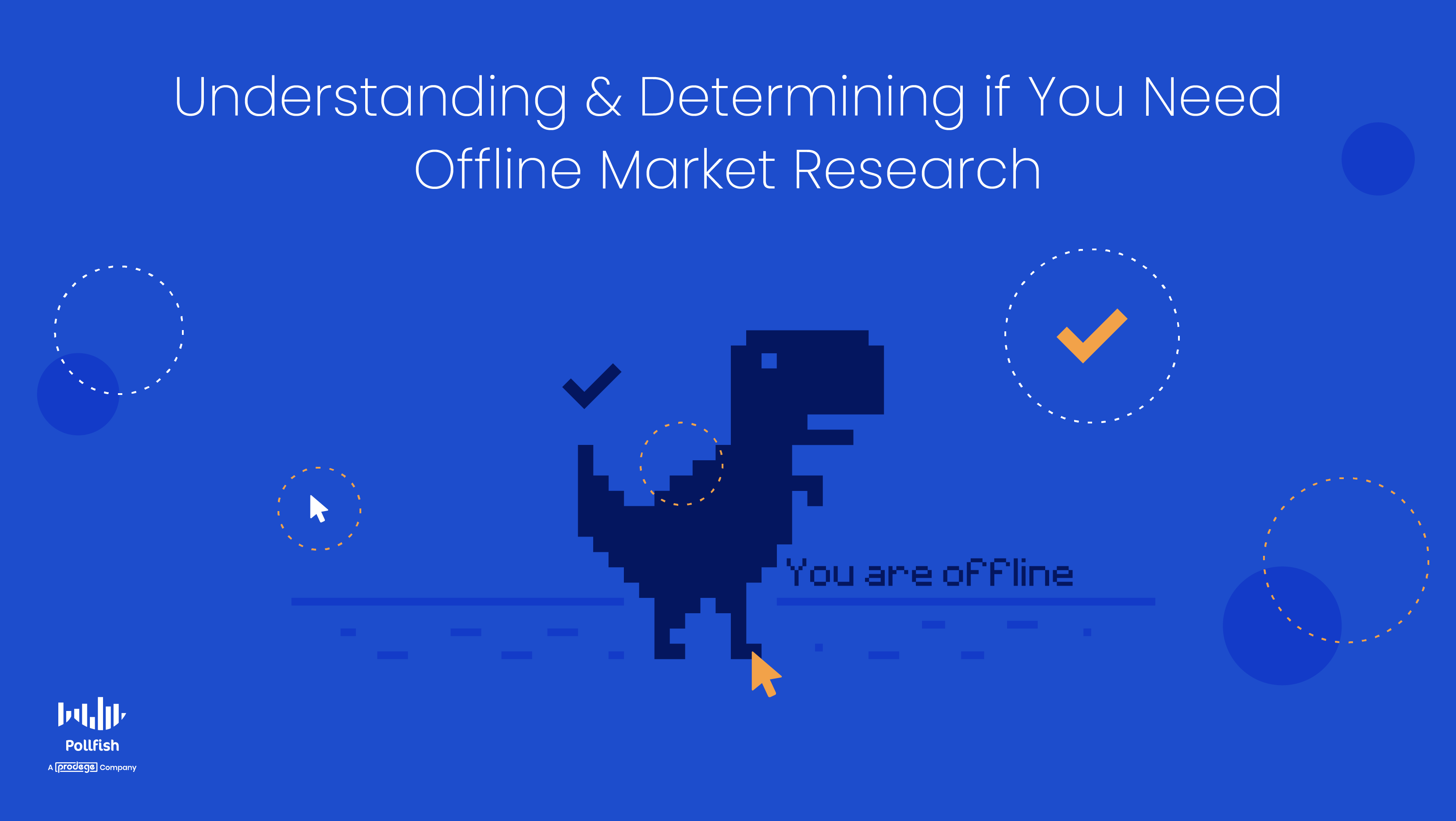
Have you ever considered using offline market research? Like its online counterpart, it too can be used to conduct both primary and secondary market research.
While we always tout market research online surveys, it is critical to understand all forms of market research. This way, you’ll always have various options on hand, which you can consider using when forming a major research campaign.
So how exactly is this industry faring in terms of revenue?
The market research industry has grown more than twofold since 2008, exceeding $76.4 billion in 2021 alone. Clearly, businesses are seeing the value in conducting this research for various business matters.
As such, we cannot stress the importance of market research enough. Again, studying just one facet of it is not enough. Thus, we suggest you get acclimated to offline methods of market research.
This article investigates offline market research, presenting the various methods used to carry it out, comparing it with the online variety, and ultimately, determining if you need to conduct it.
Understanding Offline Market Research
This is a kind of market research, except unlike most of the kinds of research performed in the current day, it is conducted entirely offline, as its name alludes.
Like its online counterpart, offline research has various methods that make it up. These methods can be far-ranging as well as of the subtype variety (for example, there are different types of ethnographic research or different types of surveys).
Offline research entails that the researcher has to do all the work to gather the research information, whereas, with online research, many of the tasks associated with obtaining the research are automated.
As such, offline research involves scouring through various sources and locations in order to find relevant information. This may include libraries, bookstores and newsagents. It may also require speaking with people with knowledge of particular subjects.
It, therefore, tends to be more time-consuming and may require traveling to come across the information.
Offline market research methods have been around for a long time, far exceeding the existence of online market research, for obvious reasons. Some of these methods are still in use to this day.
When used correctly, these offline methods are proven to yield results. As such, if you only use online market research methods, it may be worth considering offline strategies as well.
The Main Types and Methods of Offline Market Research
Offline research methods are a diverse mix and can thus cater to the needs and preferences of all researchers. Many of these methods are still around and can be used in tandem with online research methods.
Here are some of the most prominent offline methods for conducting market research:
In-Person Surveys
When surveys are conducted in person, they are considered to be interviews. Specifically, in market research, these are known as IDIs, or in-depth interviews. After all, when you speak with someone in person and face to face, there is a greater opportunity to collect as much information as possible.
This is due to the fact that such a setting allows for conversation, whereas written and online surveys are limited to the questions included in their questionnaire.
You can conduct in-person surveys in a twofold way: they can be preplanned or spontaneously / on the spot.
With the former approach, you would have to seek interview subjects and ask for their consent to participate in an interview. The interview would take place at a designated facility or a location most convenient for the participant.
With the latter approach, you can do so in public places that get plenty of traffic.
Many businesses prefer conducting these interviews in malls since their customers and target market members go there to browse products and shop. This method is advantageous, in that you can show your customers your products and have them form their opinions immediately.
As such, this method is especially useful for B2C businesses. However, it can also highly benefit B2B businesses, but these interviews would then be conducted at tradeshows or other events B2B companies frequent. They can also be conducted in-office or at your place of work (showrooms, stores, etc).
In IDIs specifically, a moderator spends between 30 minutes to over an hour having a comprehensive discussion with their participants one-on-one. IDIs are thus one of the most intimate and information-yielding approaches you can take with the survey route.
Snail-Mail Surveys
This is one of the oldest market research methods and though it may seem dated, it is still used in the present, especially to gain insights from older generations.
Snail-mail surveys are sent to respondents via the mail, for them to fill out the surveys and send them back to the researchers.
This approach can appease many older customers, especially if they aren’t physically capable of going to an in-person interview or aren’t adept at using computers to take an online survey.
These surveys are useful, as they show which customers are more likely to remain customers or buy from your business. Otherwise, why would they take the time to complete your survey, and then have to package it and send it back?
What’s best is that these provide you with a list of customers whose contact information you have. You can then cross-reference your list of contacts with the list of respondents who actually partook in your mailed surveys to have an understanding of those who are most serious about doing business with you.
Snail-mail surveys do have their share of downsides: they require far more time to fully conduct, as it takes more time to deliver them, have them filled out and finally, returned back. On the contrary, an online survey campaign can be completed in its entirety in a few hours.
In addition, if your survey includes open-ended questions, then your campaign is at the mercy of your respondents’ handwriting, which may not always be legible.
Phone Surveys
Yet another survey method, phone surveys are somewhere in between in-person survey interviews and snail-mail surveys, in terms of the time and effort required to complete them. They offer the same convenience as in-person surveys, as they too can become IDIs.
That’s because when you’re on the phone, you are free to ask and speak for however long you see fit (within reason). Unlike written surveys, phone surveys aren’t limited to the questions in a written survey’s questionnaire.
You can create new, follow-up questions as the phone conversation progresses. Thus, the data you extract from phone surveys is more comprehensive and may not require conducting any further primary research.
Phone surveys also have a major convenience over in-person surveys: the respondents don’t have to travel or even leave their homes to partake. This is especially critical during Covid and seasonal illnesses.
Additionally, some people prefer to stay home, and thus would much rather stay home for a survey session, rather than having to waste time getting to a certain location.
Phone surveys do have certain disadvantages. First off, not all will be willing to give up their spare time to talk with a stranger on the phone about a business or business-related manners.
Additionally, another major drawback of phone surveys is that many businesses don’t have enough contact information of their customers. They certainly don’t have the contact information for target market members who are not direct customers.
Thus, there are too many resources needed to dial respondents’ numbers and administer the surveys.
Focus Groups
A focus group is a small group of people who meet to informally discuss your topic of choice; this is usually business-related. However, it can also focus on the customers themselves, such as their lifestyles, buying patterns and more.
Focus groups are group sessions consisting of 5 to ten participants. They include a moderator, who leads the discussion using prearranged questions and topics.

A typical in-person focus group will consist of 4 to 12 participants, along with the moderator. A focus group session usually lasts a few hours and can require follow-up meetings.
The moderator leads the meeting with different topics and subtopics for roughly 60 minutes to two hours.
Aside from leading the discussion, the moderator must observe the group and take notes to record key moments in the session. Therefore, the focus group may also include using participant activity materials and audio/video recordings of the sessions.
Aside from taking part in a Q and A, a focus group can include other techniques to draw out insights from customers. These include doing role-playing exercises and more. As such, this method is more lively and interactive, as it includes more people than a one-on-one interview and more techniques aside from questioning.
Like in in-person and phone surveys, the resultant data from focus groups is more in-depth but it also tends to be more subjective. The output, therefore, involves more words, images, impressions and sentiments, rather than hard, statistical data.
In addition, some participants are more extroverted, leading them to dominate the discussion, while more demure participants remain quiet or answer fewer questions. This is where a one-on-one research method may be more useful, or easier to administer.
That’s because, technically, the discussion can be balanced, even with a mix of reserved and outspoken participants, but the moderator would have to step in so that the quieter participants can take part and the extroverted ones to allow others to speak. This would thus be more laborsome.
Observations
Like in-person interviews, observations typically occur in natural settings, that is, where people exist voluntarily.
Observations are part of ethnographic research, a qualitative research method that relies on entrenching yourself in various participant environments to extract challenges, goals, themes and more.
At times, it is best to observe customers in this way, noting where they choose to browse versus where they buy from, whether they’re looking for sales/promotions and more.
Thus, you can conduct observations to uncover real behaviors. This is a major advantage of this method, as people in surveys and focus groups may lie, as they are put on the spot (in offline surveys, that is, online surveys can be fully anonymized).
But when you discreetly observe shoppers in their natural habitats, they exist as themselves. They’ve got no one to impress or worry about judging their answers. Thus, you can learn a lot about customer buying behavior, customer motivations, needs and more, all by simply watching them covertly.
Some researchers observe shoppers and then use their findings to conduct follow-up interviews. Some research companies resort to using hidden cameras to record customers and gather information this way. Thus, some offline market research methods are also digital, even though they are not internet-based.
Like other methods, observations have some limitations as well. First off, you’ll need to find an ideal distance to observe customers discreetly, while being able to hear (and see) them. This can be difficult in crowded places, which tend to be loud and full of motion.
Most likely, in such scenarios, you won’t hear much of what your customers say to one another, unless you’re at a relatively quiet location.
In addition, while observing customers is useful, it won’t address your specific questions. Thus, observations are rarely a standalone affair.
Live Events
Using live events for market research is much like the above example of observation, except rather than observing people in basic, everyday settings, you’re going to observe them in special occurrences and planned events.
These can provide a mix of entertainment and research. The goal is to get the participants as engaged in the event as possible. This is typically a tactic of field marketing but can be applied to market research as well.
That’s because live events are a new type of market research called “engagement marketing,” which includes a mix of live elements, face-to-face discussions and even certain activities to enable customers to actively engage with your brand.
Conducting research at live events is crucial, as it can be more intimate than observations alone. Given that these are specialized events within your industry, you may set up a booth or nook with the intention of speaking with your potential customers.
With the customers’ consent, this can be treated as an interview, or at the very least, a time to pitch your product or service and get the opinions of it from your target market.
Thus, you can interview customers right then and there. This immediately transforms the event to be more than just a time for brand awareness, but to reap critical insights.
Live events have the disadvantage of the lack of time: both for you and your customers. That’s because many may attend such events without the desire to speak with businesses, let alone be interviewed by them.
As for you, you may be at the event with other tasks, such as making a presentation, pitching a product, handing out flyers, etc. Your business would need to dedicate a worker entirely for the purpose of research to actually get anything done on this front at a live event.
The Pros and Cons of Offline Market Research
As we’ve discussed in the prior sections with examples of offline research methods, we’ve alluded to both the positive and negative aspects of such methods.
You can draw your own conclusions, but to do so, it’s useful to have a concrete view of all the advantages and drawbacks of these methods.
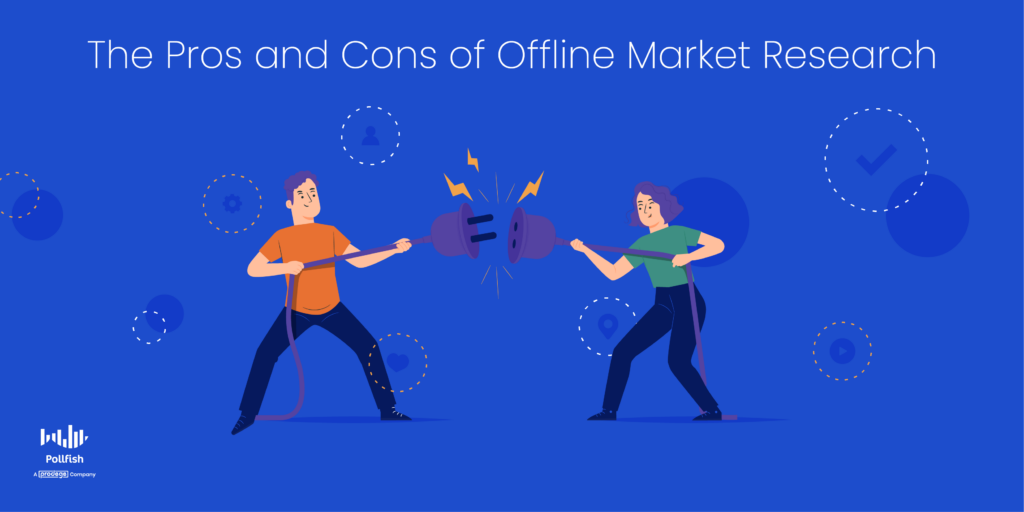
The following does just that, listing all the pros and cons of offline market research methods:
The Advantages:
- Reaching participants who don’t have access to the internet.
- 6% of Americans don’t have adequate access to the internet at threshold speeds or with a fixed broadband service.
- Being able to reach participants who aren’t internet savvy, don’t have internet devices or simply prefer not to use the internet.
- Having wide-ranging approaches to conducting research if one doesn't garner enough data, whereas online research may only rely on one software, aka, one method.
- Not all participants spend a lot of time online; this is especially true of those with eye strain.
The Disadvantages:
- A much smaller reach to participants than in online research methods.
- Secondary online research methods are easier to come by, doing so offline requires finding and speaking with a knowledgeable source.
- They tend to all be time-consuming affairs.
- Lack of time for deep thoughts in all in-person and phone methods.
- It can be difficult to get people to answer all your questions, whether in written form or in person.
Offline Vs Online Market Research: The Verdict
Both offline and online market research methods have their advantages and pitfalls, but which is overall the best approach to take when conducting market research?
Offline market research provides many avenues that online research simply doesn’t, such as the personal touch of conducting in-person studies. That’s the major advantage of offline research over the online variety.
It is nearly impossible to create the same conversations and reap the same information digitally, or even over the phone. Thus, offline research methods are better for drawing out qualitative market research. That’s because they involve discussing thoughts, feelings and perceptions in full depth.
This can be limiting, however, as respondents may not remember or gather all of their thoughts on a subject right away, especially in an in-person setting, which puts more pressure on them. On the contrary, there is hardly any pressure in taking an online survey.
In addition, conducting offline research is much more difficult for obtaining quantitative market research. The reason behind this is twofold:
- Offline studies take much more time to conduct and complete.
- One focus group session alone can take hours.
- Mail-in surveys can take months, even years to complete, depending on the respondents.
- Calling people to ask for consent to a research project, as well as mailing them takes too long, and this is just to opt people in.
- Offline market research reaches fewer people.
- Many will ignore survey phone calls and snail mail surveys.
- There are only so many adequate observations you can make on a daily basis.
- A focus group itself only deals with 12 people at most.
Online market research solves both of these problems, as it can be deployed to the masses and completed within hours. This will, of course, depend on the market research platform you use.
Moreover, online research involves using polling software that targets the specific people you need for your research study. With offline market research, finding people who meet a variety of qualifications and who are also willing to take your survey is nearly impossible.
Online market research can also involve tactics that prevent poor-quality data and survey fraud by using AI to detect it and disqualify respondents who provide this data. This involves giving gibberish answers, skipping questions, and more. This is impossible to do in written, snail-mail surveys.
Thus, online research offers far more capabilities with survey software than does offline market research. Online market research can obtain both quantitative and qualitative research, reach the masses and do so in a timely manner.
However, it still is lacking in some regards, especially when compared with offline market research.
That’s because not all segments of the population spend much time online. Some segments do not have reliable internet access, as aforementioned, such as rural citizens. You may also have less tech-savvy, older customers.
You will therefore need to reach these segments offline.
In addition, offline market research gives you more access to primary sources of information and yields more comprehensive results.
Thus, it is often best to use both, specifically, whichever method is most suitable for your research needs. Using both will reveal different data about your target market.
Aiding All Your Market Research Projects
Although we suggested taking your market research endeavors both online and off, there’s more to this.
An online market research campaign is only as effective as the platform you use to administer it.
In essence, it is the survey platform that grants online surveys all their powers.
We therefore advise you to use a trustworthy online survey platform, one that is rich in functions and features.
Not all survey platforms have the same features; thus, not all market research online surveys can offer all of the functionalities and features mentioned in this article.
Thus, you should select your survey platform carefully.
Pollfish survey software allows you to create a thorough survey data collection, one you can customize to your liking, view however you please and organize to the max.
In addition, with our vast array of question types, you can create virtually any type of online market research survey to support your research campaigns.
Researchers can leverage a wide range of information on their respondents by accessing a wide pool of insights in their survey results dashboard.
In addition, we also offer the advanced skip logic feature, which routes respondents to relevant follow-up questions based on their answers to a previous question.
Thanks to our advanced market research platform, you can effectively pair online market research with offline market research campaigns.
How to Use Various Matrix Questions (Updated)
How to Use Various Matrix Questions (Updated)
A Matrix question is a group of multiple-choice questions displayed in a grid of rows and columns. The rows present the questions to the respondents, and the columns offer a set of predefined answer choices that apply to each question in the row. Very often the answer choices are on a scale.
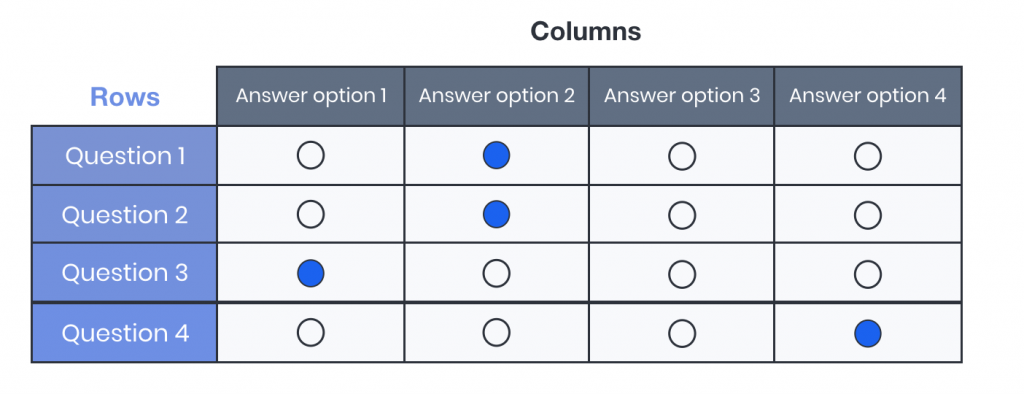
When to use Matrix Questions
It is best to use Matrix questions when asking several questions in a scaled format about a similar idea. They can be applied either as a mini-survey on their own or as a single-question type within a larger questionnaire. The closed-ended, predefined answers that apply to a series of questions make Matrix questions great for:
- Customer experience/satisfaction surveys.
- Questions about a subtopic in a larger questionnaire.
- Combining many rating-scale questions in a more digestible format.
Customer experience surveys
Matrix questions are commonly used in customer experience surveys. For example, to ask a respondent about their experience on a flight, the rows might ask the respondent about the service, food, or entertainment while the columns ask them to choose a rating response.
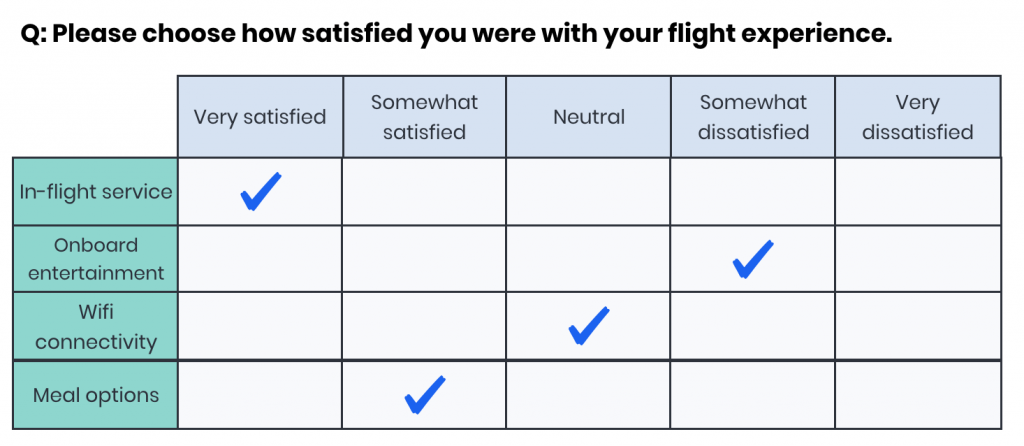
Questions about a subtopic
Oftentimes a questionnaire includes many ideas, but some of them are specific to a subtopic within that survey. Matrix questions are an effective way to cluster these ideas into a format the respondent can easily understand.
For example, in a brand awareness survey, a customer might use a matrix to get more information on brand perception.
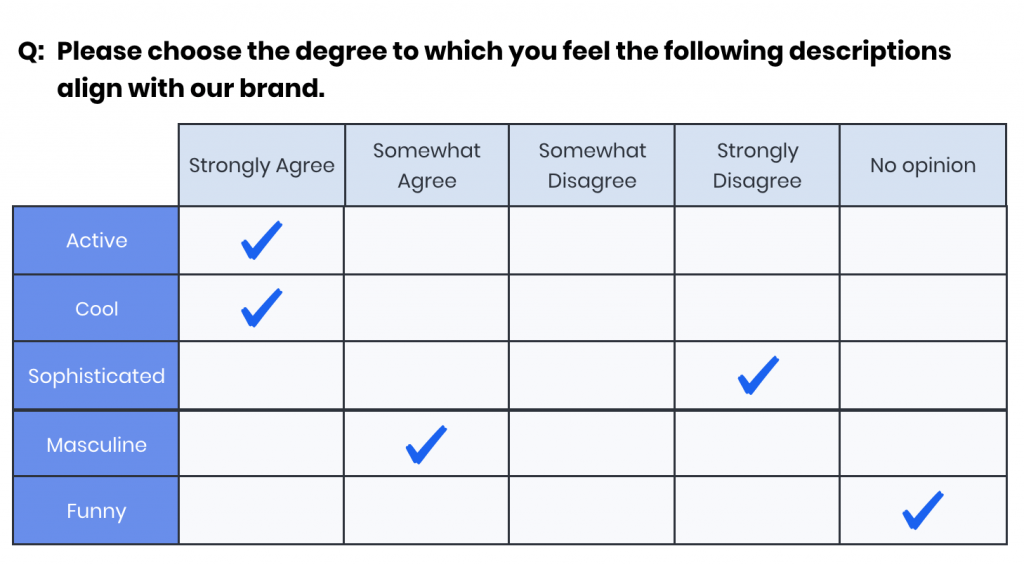
Benefits of Matrix Questions
The format and structure of Matrix question types supply some unique benefits. Because it is a series of questions presented as a single table, it appears as a single question on the survey. This has the benefit of saving space (both on paper and in a digital survey) as well as reducing drop-offs from respondents who do not want to answer five nearly identical questions back-to-back.
The grid is easy and intuitive for respondents to follow with closed-ended, predefined answer sets, which means quick responses and a clear, easy-to-analyze dataset as the outcome.
Drawbacks of Matrix Questions
While there are many benefits, there are a few things to keep in mind when using Matrix questions.
The table formatting, while easy for respondents to answer, can also result in activities such as “straight-lining” or other pattern-making within the table.
Another issue can be the addition of too many rows or columns, which may negatively affect the data quality. If there are too many choices, respondents might lose interest (and be more likely to enter insincere answers to move quickly through it). In some cases, this can affect formatting as well, particularly in a digital survey environment such as mobile. If the Matrix question is not designed for an optimal mobile user experience, it can be confusing or frustrating for respondents.

Some survey companies will also charge for each row in the Matrix, as though they are individual questions, which may change the cost of the overall survey. Keep this in mind when building your questionnaire. (Pollfish views Matrix questions as a single question type, so pricing does not vary based on the number of rows and columns included).
Types of Matrix Questions: Single- Selection vs Multiple-Selection & Multiple Matrices
Matrix questions, like regular multiple-choice questions, can be either single-selection or multiple-selection. This means that a respondent can choose either a single answer choice per row or they could choose multiple answer choices per row.
Competitive analysis surveys might include Matrix questions to better understand how a product or brand is measuring up against competitive offerings.
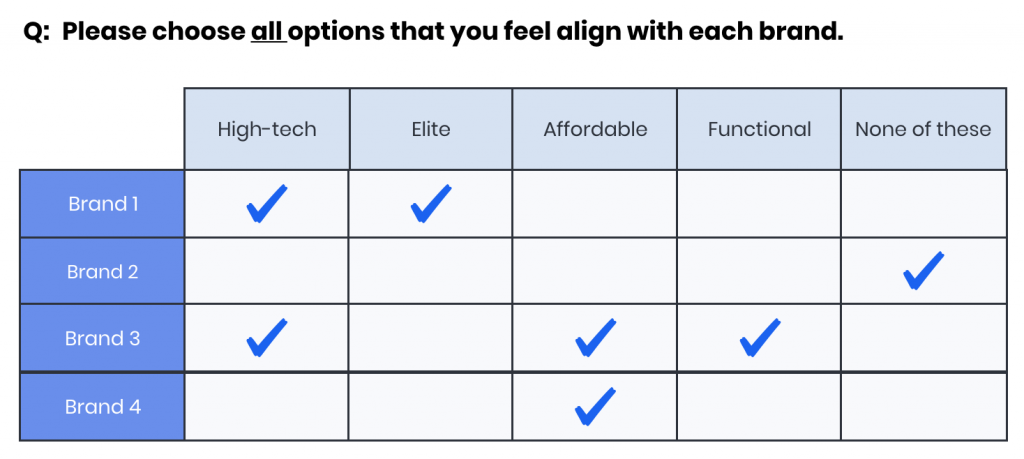
Exclusive Answers for Multiple Matrices
You can create exclusive answers from the scale points of multiple matrices.
As we realize the need to allow researchers to mark answers as exclusive in a Matrix table, you can do so by using the Multiple Selection question type.
Here's how it works: when a respondent selects a specific scale point as an answer to a statement, all the other scale points become de-selected, much like in the exclusive answers in the Multiple selection question type. Thus, the scale point marked as "exclusive" is an exclusive answer for every statement.
Keep the following in mind: after starting the survey, the respondents cannot modify any exclusive answer flag. You can make multiple scale points become exclusive.
https://www.loom.com/share/99bf9711898e495d88e9ad8da296324c
How Matrix questions differ from a Likert Scale
Many people believe that a matrix question is just a Likert scale, when in fact, it is the other way around.
A Likert Scale is a specific type of Matrix question designed to measure opinions linearly. Using a 5- or 7-point scale to collect user sentiments, a Likert Scale can be used to determine scaling attitudes such as:
- Agreement (Strongly Agree- Strongly Disagree)
- Likelihood (Very Likely- Not very likely)
- Importance (Very Important- Unimportant)
- Frequency (Always- Never)
- Quality (Excellent- Poor)
A Matrix question is a format for the question, meaning it is presented in a grid (or matrix). While Matrix questions often happen to be Likert Scales, Matrix questions can also be applied across a variety of use cases outside of attitudinal measurement, as shown above.
Best practices for writing a good Matrix question
Writing a good Matrix question follows many of the same best practices for writing good survey questions in general. However, due to the grid formatting, there are a few other things to be aware of.
- Limit the number of rows or columns. Keep it around five different options for questions and answers so as not to bore or overwhelm respondents.
- Give respondents a way to opt-out of things they are not familiar with, such as a “no opinion” or “neutral” answer choice.
- Do not make the questions too long. In the table format, long questions create a poor respondent experience.
- Try to group like-concepts. For example, if you want to know about brand perception, keep the questions related to that subtopic.
- As in any closed-ended scaling question type, keep scaling answer choices in order so as not to confuse the respondent.
Matrix question types are available in the "questionnaire" section of the Pollfish survey builder. Sign in or create an account to get started on your next survey.
Frequently asked questions
What is a Matrix question?
A matrix question is a group of multiple-choice questions displayed in a grid of rows and columns. The rows present the questions to the respondents, and the columns offer a set of predefined answer choices that apply to each question in the row. Very often the answer choices are offered in a scale.
When do you need to use Matrix questions?
Matrix questions are best used as to ask several questions about a similar idea when there is a scale involved. They can be used either as a mini-survey on their own, or as a single question type within a larger questionnaire.
What kinds of surveys and contextual questions are Matrix questions good to use for?
Matrix questions are great to use for closed-ended, predefined answers that apply to a series of questions. These are appropriate for customer experience/ satisfaction surveys, questions about a subtopic in a larger questionnaire and for making rating-scale questions more digestible.
Are Matrix questions a type of Likert scale?
It's the other way around. A Likert Scale is a type of matrix question that is designed to measure opinions in a linear fashion. Using a 5 or 7 point scale to collect user sentiments, a Likert Scale can be used to determine scaling attitudes.
What are the two types of Matrix questions?
Matrix questions can be either single-selection or multiple-selection. This means they can either be a single answer choice per row, or they could choose multiple answer choices per row. These might be used in competitive analysis surveys to understand how a product or brand is faring against competitive offerings.
Frequently asked questions
What is a Matrix question?
A matrix question is a group of multiple-choice questions displayed in a grid of rows and columns. The rows present the questions to the respondents, and the columns offer a set of predefined answer choices that apply to each question in the row. Very often the answer choices are offered in a scale.
When do you need to use Matrix questions?
Matrix questions are best used as to ask several questions about a similar idea when there is a scale involved. They can be used either as a mini-survey on their own, or as a single question type within a larger questionnaire.
What kinds of surveys and contextual questions are Matrix questions good to use for?
Matrix questions are great to use for closed-ended, predefined answers that apply to a series of questions. These are appropriate for customer experience/ satisfaction surveys, questions about a subtopic in a larger questionnaire and for making rating-scale questions more digestible.
Are Matrix questions a type of Likert scale?
It's the other way around. A Likert Scale is a type of matrix question that is designed to measure opinions in a linear fashion. Using a 5 or 7 point scale to collect user sentiments, a Likert Scale can be used to determine scaling attitudes.
What are the two types of Matrix questions?
Matrix questions can be either single-selection or multiple-selection. This means they can either be a single answer choice per row, or they could choose multiple answer choices per row. These might be used in competitive analysis surveys to understand how a product or brand is faring against competitive offerings.
How to Get Survey Responses to Complete Your Market Research Needs
How to Get Survey Responses to Complete Your Market Research Needs

When dealing with online surveys, you’ll surely ask yourself how to get survey responses, or at least, how to get more survey responses.
We hear you! Any market research campaign needs a particular amount of surveys for statistical relevance and to lessen the margin of error.
However, survey response rates still tend to be on the lower end of the scale, as the current survey response rates are at about 30%. Thus, there is clearly work that needs to be done to increase this rate so that you can reach a suitable number of survey responses.
However, despite the rather low amount of respondents that take a survey, surveys are still popular — for both researchers and their target audiences.
Online surveys in particular, are a popular route for conducting market research. Both researchers and survey respondents can attest to this.
For example, 71.6% of respondents prefer to answer a survey online. Thus, you should consider updating your market research methods by using online surveys.
This article guides you how to get survey responses so that you get an adequate amount of completed surveys to aid any research campaign.
How to Get Survey Responses Via 2 Survey Distribution Methods
Before we discuss how to increase your survey responses, please note that we are providing this advice for those who use our Distribution link feature.
This feature gives you more freedom when it comes to posting surveys online, as you get to choose where to post the link for people to take your survey, as well as who gets to take your survey, if you’re thinking of sending it to specific people.
This method is one of our major two; the other involves our Random Device Engagement (RDE) method of distributing surveys. With RDE, our platform sends surveys to a massive network of online properties, such as websites and apps.
The surveys target people randomly, given that RDE runs on organic sampling. That means there is no prerecruitment, which you would find in a survey panel. Instead, the platform targets random people who voluntarily exist in a particular digital space.
We target over 250 million people in over 160 countries to gain your respondent pool. Following agile research, this method keeps iterating surveys until the designated amount of respondents have completed their survey.
Thus, you don’t need to worry about getting survey responses via this method. However, if you send surveys your own way, that is, with the Distribution Link feature, you’ll need to have a solid plan on how to get survey responses, especially if you seek a certain number of responses within a certain time.
Fortunately, we provide several tips on how to get more survey responses.
Draw in Responses with a Strong Survey Intro
First responses matter and this applies in survey participation as well. That’s why you’ll need to reel in interest to your survey as soon as you can.
This entails compelling your potential respondents to take your survey as soon as they come upon your survey.
Everyone sets up their survey differently. Yours may exist as a pop-up, while others may position it right below a large image.
Regardless of the form of the call-out you use to grab people’s attention to take your survey, you’ll need to supply it with a strong introduction. This must be interesting, compelling and show respondents why the survey is important and why their participation matters.
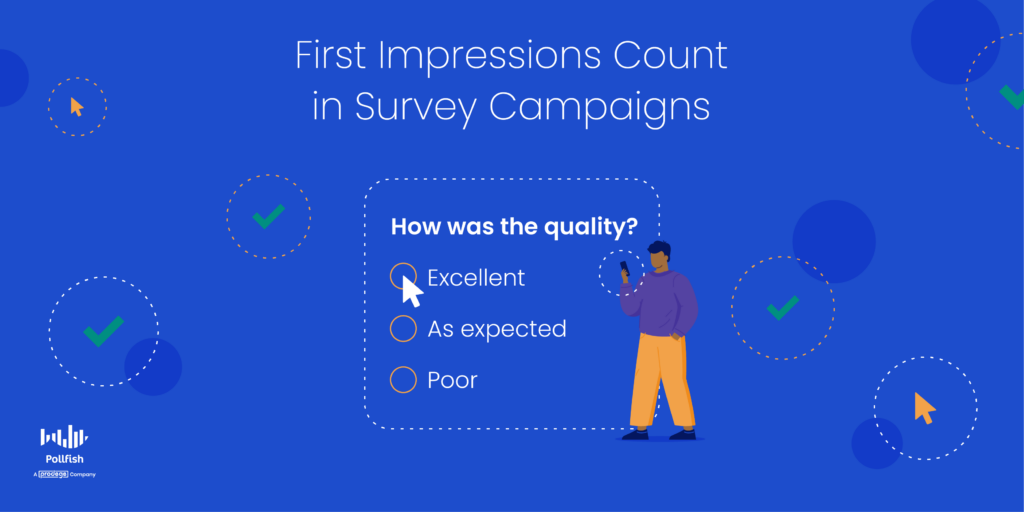
As such, use short and snappy survey titles and call-outs.
To ease anyone’s dread, you may want to consider adding the time it takes to complete the survey in your title or introduction.
This is to reassure your respondents from the onset that the survey won’t take much of their time.
It’s also useful to add the purpose of the survey title and introduction, especially when it relates to helping the respondents themselves.
Example text: “Take this quick 3-minute survey to help brands serve you better!”
Create a Survey with Survey Best Practices
You should never just wing it when it comes to producing surveys; instead, apply the best practices for surveys each time you create a survey.
These will ensure you provide a good survey experience for the respondents, as well as receive the key data that you need for your market research campaigns.
While you can’t please everyone, several survey best practices are tried and true. The following provides several best practices you should consider for your surveys:
- Keep your questionnaire short.
- Many are time-poor and no one wants to waste their time.
- Keeping the questioning short will prevent respondents from leaving your survey before completing it. In this way, you’ll prevent or at the very least minimize survey attrition.
- Some respondents won’t even begin your survey if it’s too long.
- Remove any ambiguity from your questions.
- Surveys aren’t a knowledge test for school. As such, your questions should be easy to understand and answer.
- Avoid any confusion and be as direct as possible.
- When questions are difficult to answer, respondents will be bent on leaving the survey or getting bored quickly.
- Mix and match question types to retain interest throughout the survey-taking process.
- You can ward off respondents from getting bored by using a variety of question types and formats.
- Use questions such as: Likert scale questions, Matrix questions, stars and emoji scales, bipolar questions, drill-down questions and more.
- Make sure the survey platform you use allows you to do so.
- Find an adequate time to send your survey.
- This will depend on the lifestyles and habits of your target market.
- You can determine this by conducting a target market analysis to see when your target audience has more time in their day, when they go online, etc.
- Also, there are some general times and moments in the customer journey determined to be the best time to send a survey.
- Thank the respondents and follow up.
- Include a thank you page in your survey to give thanks to respondents for their time and consideration.
- You can also do so in advance by thanking respondents in the intro of the survey.
- Follow up with respondents whose contact information you have. There are many ways to go about this, including with the results of the survey, to thank them and more.
Strengthen Interest with Survey Incentives
Another strong approach to getting survey responses is to reward the respondents with survey incentives.
These incentives can be either monetary or nonmonetary and you can get creative with your incentives to stand apart from your competitors.
This is especially important when your survey states your brand or displays its logo or any other likeness. That’s because using incentives shows generosity and care, thereby positioning your brand in a good light.
After all, your respondents will know which company they are dealing with. Thus, you should consider using incentives to frame your brand in the best possible way. Survey incentives will do this, as they prove to respondents that you truly care about their participation. Otherwise, why would you reward them with incentives?
On the contrary, if respondents see your business on your survey and it doesn’t offer incentives, this will lead to a negative impression of your brand, even if the respondents are longtime customers.
That’d because no one owes you any feedback, regardless of how critical it may be. Thus, use incentives when possible, especially in instances where respondents know your business is running the survey.
Do a Favor for Your Respondents
This is especially useful if you know your respondents or have their contact information.
Doing favors closely ties in with incentives, but it is different in that favors can be anything aside from small benefits (like extra lives on a mobile game that respondents played upon encountering your survey) or gifts.
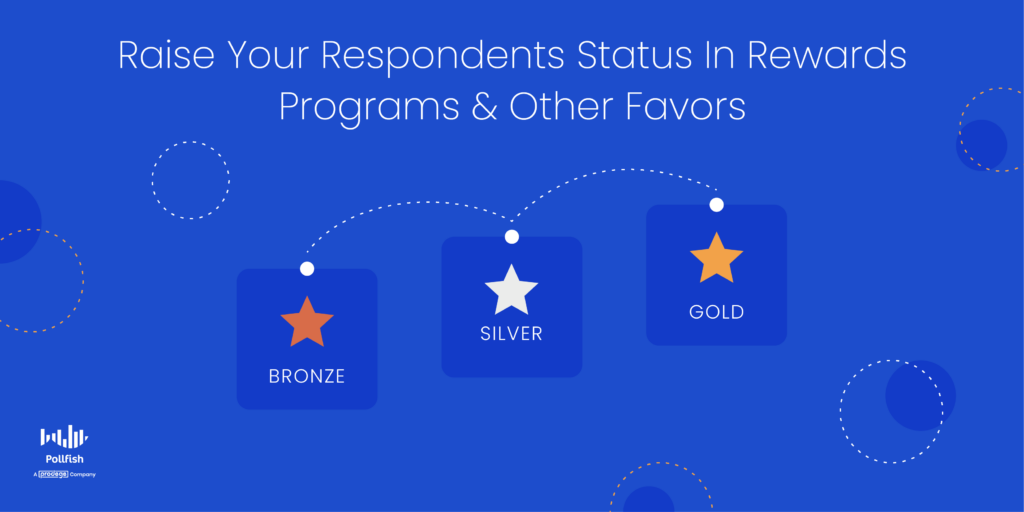
Favors can consist of doing anything favorable for your respondents. There are many routes you can take with factors, such as the following:
- Promise to give respondents a discount on your products or services.
- Offer a discount on top of an already discounted purchase.
- Enter them into a sweepstake to win a big prize.
- Raise their status if they are in a rewards program.
- Give them a preview of one of your new offerings.
As you can see, there are many kinds of favors you can offer your respondents to lure them into taking your survey.
At times, you may want to give some kind of proof of the favor you promised, such as a coupon that only goes into effect after respondents complete their survey.
Remember that what truly differentiates favors from incentives is that favors are grander and are more long-term-oriented gifts and gestures.
Use Your Content to Motivate Respondents
The content your business puts into the world has various benefits, but did you know that you can use it to encourage people to take your survey?
Not all content assets are easily accessible. That’s where you can use them to incite respondents to take your survey. This is especially true with gated content.
Content that’s gated often involves collecting users’ information in order for them to view it. In this scenario, you can require your users to take your survey to gain access to your gated content.
This is fair, given that both parties will get something in return. In addition, your site visitors won’t have to pay anything or get a membership to view the content they need, they’ll just need to take a survey.
Using gated content is especially useful for B2B matters and campaigns and therefore, B2B surveys.
Aside from granting users entry to gated text-based content, you can also gain more survey responses by giving them access to video content. Videos tend to draw in more views and engagement then text, especially in the era of Tik Tok and short attention spans.
Getting the Right Amount of Survey Participation
Getting the right amount of survey responses is never a feat with the right online survey platform. Such a platform will allow you to research all your targeted respondents in various ways, like the aforementioned RDE method and via the Distribution Link.
With the former, you won’t ever have to worry about survey responses, as the platform will keep sending surveys across the internet until your preset number of completed survey responses is fulfilled.
With the latter option, it’s best to follow our advice on how to get more survey responses. However, even in this method, our survey platform will keep iterating until the requisite number of completed surveys is reached.
Thus, your survey is in good hands regardless of the distribution route you take when you use Pollfish.
You should also consider that a strong survey platform will grant you all the functionalities necessary to build a good survey campaign, one that draws in interest and gets respondents to complete the survey.
Pollfish survey software allows you to create a thorough survey data collection, one you can customize to your liking, view however you please and organize to the max.
In addition, with our vast array of question types, you can create virtually any type of survey to aid your research campaigns.
Researchers can leverage a wide breadth of information on their respondents by accessing a wide pool of insights in their survey results dashboard.
In addition, we also offer the advanced skip logic feature, which routes respondents to relevant follow-up questions based on their answers to a previous question.
Thanks to our advanced market research platform, getting survey responses is highly attainable and easy on Pollfish.
Constant Sum Question: A New Matrix Question Type to Customize Your Survey
Constant Sum Question: A New Matrix Question Type to Customize Your Survey
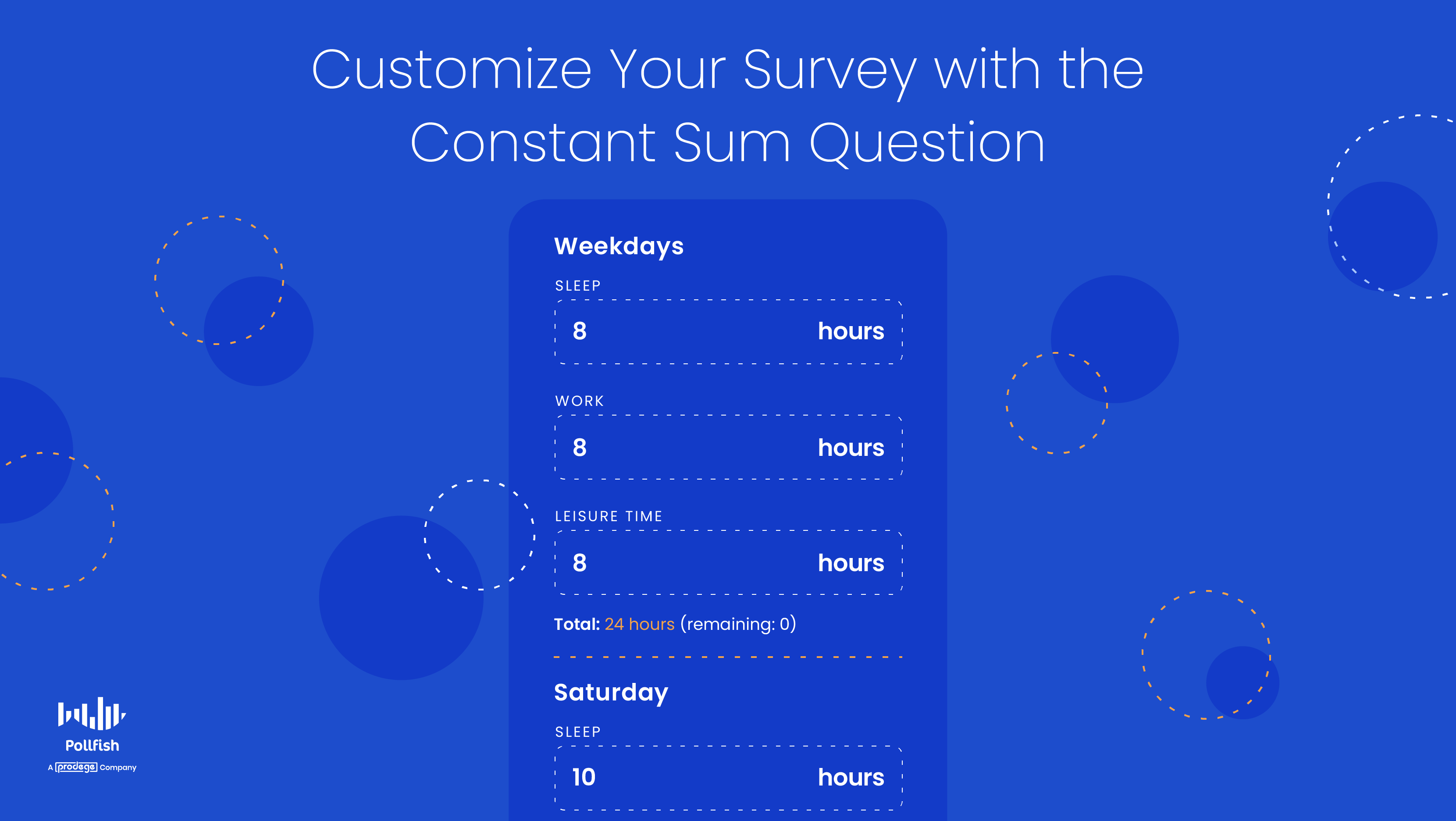
We’re thrilled to offer researchers yet another new question type to power their surveys: the constant sum question.
This can exist as a Matrix question type on the Pollfish market research platform. As such, this is an addition to another Matrix question we offer: the Bipolar Matrix question type.
As you know, surveys are a great tool to conduct both qualitative market research and quantitative market research. But now, with this new question type, you can create questions with quantitative elements.
That’s because constant sum questions enable respondents to enter numeric data, wherein each numeric entry is summed up and displayed to the respondent.
You can use this question type for a consumer analysis, along with researching everyone in your target market: donors, students, employees, partners and more.
This article explains what a constant sum question is, its use cases, importance, how to create one on Pollfish and more.
What is a Constant Sum Question?
A constant sum question is used in a market research survey; it allows respondents to assign a specific number of points to all the answer options in the question.
Thus, this is a multiple-choice question, one that requires respondents to enter a numeric value for all choices per question.
The type & total of these points can be defined by the researcher while designing the survey. When these points are defined, respondents won’t be able to answer with values that exceed the maximum points allowed.
The points can take whichever unit you wish to study, such as currency, hours, frequency, etc.
This question type allows you to calculate the numerical aspects of customers' decisions and everyday lives, allowing you to better understand their customer buying journey and virtually all else.
Let’s delve further into the usage of this question type.
Constant Sum Question Use Cases
The constant sum question type gives an understanding of how your respondents value each answer option per question.
These options revolve around a specific topic and inquiry, such as how many times within a certain time period customers buy certain products, or how they rate particular products.
Therefore, you can apply this question to a wide variety of research. The following lists key use cases of this kind of question. This is not exhaustive, as you can ask respondents to assign value to essentially all topics and issues.
- The dollar (or other currency) amount spent
- On specific items
- On certain days
- On budgets
- Amount of time
- Taking part in particular habits
- Working on a project
- Leisure time
- Taking care of responsibilities
- Percentages
- Allocating portions to various activities
- Viewpoints
- Inclinations
- Habits
- Rating systems
- Scales (1-10, etc) on products and services
- Ratings on customer service
- Easiness of a product, school or work assignments
- Ratings on overall customer satisfaction
The Importance of the Constant Sum Question
This kind of question is important for various reasons.
First off, it is useful for product research. If customers feel that certain features of a product or service are more important than others, they will allot more points to those features.
Thus, researchers will get a clear indication of the products (and product features) that customers are satisfied with and not.
Using a constant sum scale is also a great way to create differentiation within a data set. It helps you determine which factors are important and which are not for your target market sample.
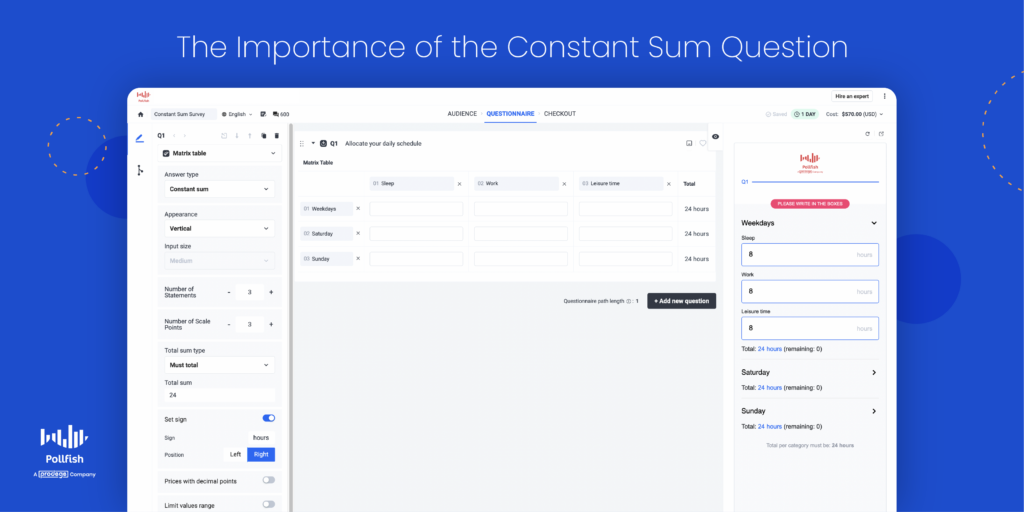
They are especially helpful in cases where many factors are critical and overlap in some sense. Thus, studying many factors is no longer a hindrance: you can just create an answer option for each factor.
The respondents will assign it a point or rating so you can see the nuances of each factor, especially when it comes to how your customers feel about them.
As such, this question allows you to study multiple aspects easily, as the data this question yields is straightforward and to the point.
This question is also important in a case where you seek to get purely quantitative data. Again, this is useful when dealing with larger sets of answer options. In this case, open-ended questions and other qualitative questions won’t be useful.
Additionally, this question type is especially convenient when you don’t want to form individual questions on a specific aspect.
This would require answer choices unique to the aspect in question, whereas, in a constant sum question, you can fill in various aspects per question.
You can see the sentiments on each aspect displayed in a simple numerical format. This is useful for maintaining a shorter survey, which is a common survey best practice.
In all, this type of question provides convenience for your study and a good UX for your respondents.
Examples of the Constant Sum Question
We dove into the various use cases of this question and now we’ll walk you through specific examples.
Example 1:
Ask respondents to allocate 100 points on the expenditures of their surplus goods, AKA, non-essential items. You can create your own point system or use a currency.
Provide a list of options and ask them to assign the points in order of importance.
Let’s say they spend $20 on movies, $70 on gadgets, $10 on miscellaneous expenses. With the constant sum question, you’ll find out which groceries are the most important for the respondents, as well as which they spend the most and least on.
Example 2:
Ask respondents their views on a particular digital experience with your business. Your answer options can include emails, customer service sessions, finding what they need on your site and more.
You can customize your scale to your liking. As such, you can use points via a scale of 100, or 10. You can also use percentages, especially when talking about the time spent on each.
It would be like this: rate the time you spent on the digital experiences with our company: viewing the homepage - 30%, reading a blog post - 20%, searching for products - 40%, speaking with a support rep via chat - 10%.
They can also rate how they viewed each experience; this would require a scale of 1-10, or 100, depending on researcher preferences.
Example 3:
You can discover how well your customers know and feel about certain brands, especially useful if they are your competitors.
As such, you can ask them to rate how they feel about each brand along with how much time they’ve spent engaging with it.
This can appear as such: rate how much you’ve engaged with each brand, which can include buying from them, viewing their items, reading their content, etc.: Macy’s- 30%, Old Navy -15%, Marshalls - 45%, Burlington Coat Factory - 10%.
How to Use the Constant Sum Question on Pollfish
Creating a constant sum question on the Pollfsih platform is easy and straightforward.
For respondents, it’s as simple as allocating a certain point to each answer option. See the section above with examples of how respondents can answer the question.
For researchers, it involves implementing the question in the questionnaire section, along with adding and customizing acceptance criteria.
Here is how to add it to your questionnaire:
- Go to the questionnaire section of the survey after creating a new one.
- Select a Matrix question and then the Answer type: Constant Sum.
- You can lift the Must total validation and change it to Continuous Sum.
- There are 2 appearances as well.
- You can add a sign (if you seek) and select if you accept decimals or not at responses.
 Create the survey you want
Create the survey you want
The Pollfish team is constantly working to improve your survey experience, so you can expect us to continue updating and upgrading our platform with more features.
With our vast array of question types, you can form any survey and any research campaign.
Our research platform is optimized for both the respondent and the researcher. Thus, it is a win for all parties involved.
Researchers can reap a wide breadth of information on their respondents and leverage a wide pool of insights in their survey results dashboard.
Pollfish also provides artificial intelligence and machine learning to remove low-quality data and a broad range of survey and question types to customize your surveys.
In addition, there’s the advanced skip logic feature, which routes respondents to relevant follow-up questions based on their previous answers.
With a research platform containing all of these capabilities, you’ll be able to set up any survey you want, study any group based on demographics and psychographics alike and reap high-quality data.
Where Can I Post Surveys Online — and Other Concerns
Where Can I Post Surveys Online — and Other Concerns
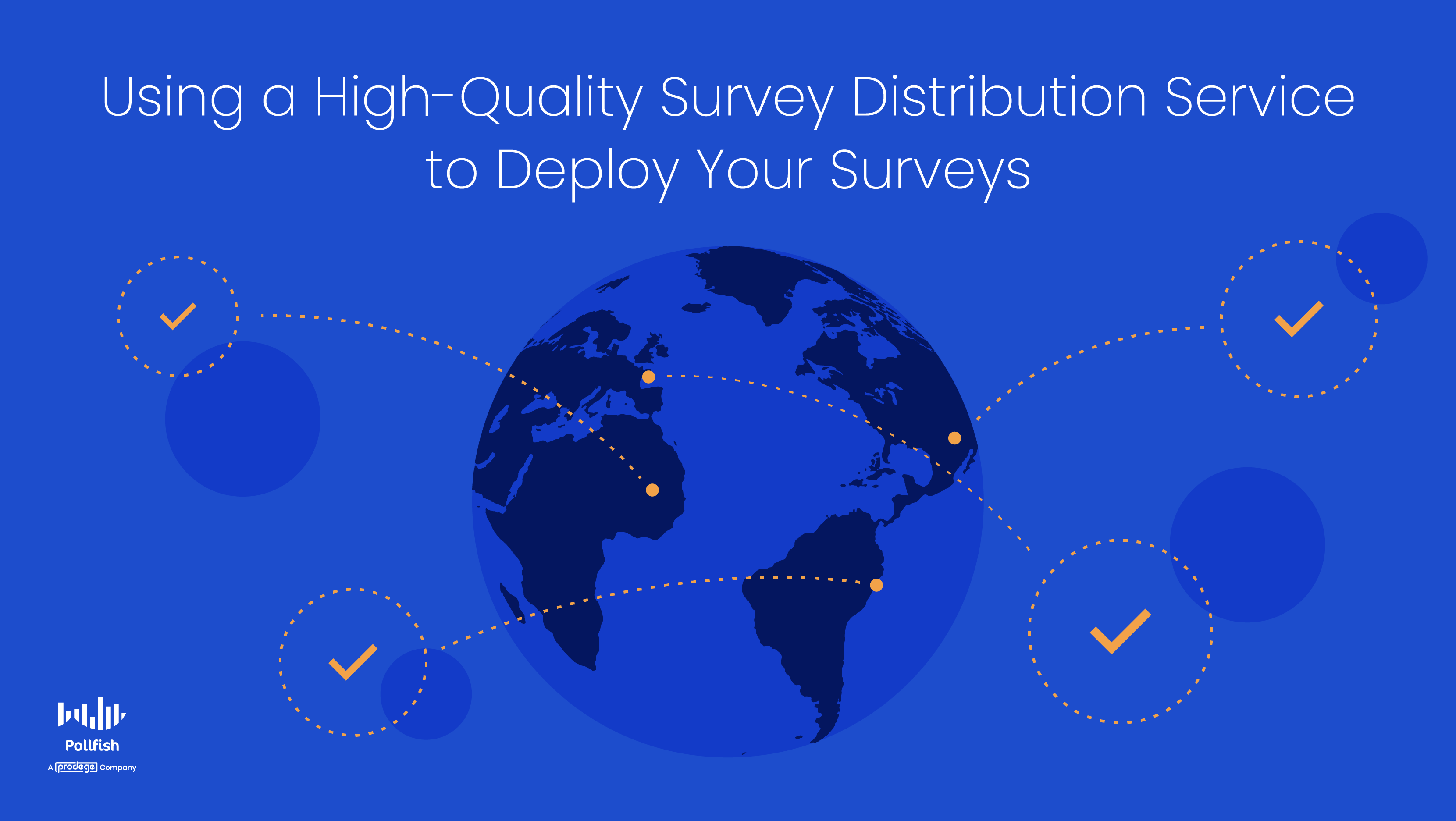
Where can I post surveys online? We know you’ve got questions — and not just for your survey target audience. You’re probably brimming with questions on how to use an online survey platform with all of its capabilities, features and methods in the survey process.
Fortunately, we’ve got you covered on things survey and market research-related.
If you haven’t used survey research before, we suggest doing so, as online survey software industry in the US has grown 5.0% per year on average between 2017 and 2022.
And for good reason. Surveys provide an easy and quick method to obtain key insights on those who matter most to your business: your customers.
You should therefore opt for an online survey platform to learn the nitty gritty of all members of your target market — the group of people most likely to buy from your business.
While we can’t address every concern you may have in just one article, we can make certain related topics clear. When it comes to posting surveys online, you’ll need to know how this can be done, namely, the two major methods making this possible.
There are a few other related things you ought to know, which this article will cover.
This article lays out answers to key questions about conducting surveys, such as where can I post surveys online and others.
How Can I Post Surveys Online?
When it comes to posting your surveys online, there are two main methods underpinning this endeavor.
The first gives you less leeway on where your survey will appear, but is one of the most powerful ways of reaching a wide audience across the internet — and the world. That’s because it involves organic sampling, which reaches people randomly on the internet.
Depending on the survey platform you use, you may be able to cast a wide net when it comes to reaching a diverse population, across a multitude of online platforms.
The second method involves more specificity; researchers get to choose which platforms their surveys will be on. That’s because it involves posting a link to the survey in various digital channels that you as the researcher select.
Or, you can send the link to specific people via email, social media or some other means.
Not all survey platforms offer both of these capabilities of posting your survey online. We suggest leveraging a platform that powers your research with both methods.
Random Device Engagement (RDE)
Random Device Engagement is Pollfish’s signature approach to the aforementioned random sampling method. With RDE, surveys are sent to a massive network of over 250 million+ websites and apps, prompting users that exist in their natural digital environments to take the surveys.
As such, you survey will exist in different websites, mobile sites and mobile apps, where consumers are engaged and can be easily incentivized non-monetarily.
This eliminates the survey bias that can occur if you were to use a survey panel.
Professional panelists are not taking a survey in their natural environments online; instead, they are pre-recruited, which means they are not fully anonymous. They can easily feel compelled to answer surveys in a certain way, tainting the accuracy of the survey study.
They are also prone to panel fatigue from constantly having to take surveys. They may also be influenced by certain questions, which then affect how they answer future ones. This is known as panel conditioning.
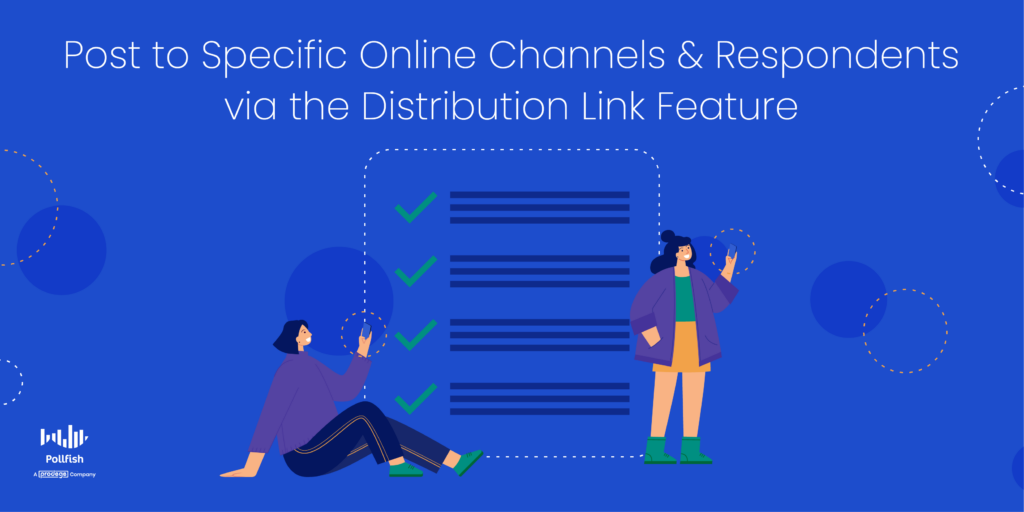
On the contrary, Random Device Engagement reaches and recruits respondents in the places they naturally frequent online. This means that respondents’ participation is completely voluntary, anonymous and randomized.
As such, respondents are more likely to answer truthfully and are less prone to survey fatigue. After all, respondents’ identities are completely anonymous, since they haven’t been pre-recruited and vetted through a panel recruitment process.
Thanks to RDE, you can reach a wider scope of people and segments in your target market. This is because it is conducted across a wide network of sites and app publishers that deploy your surveys.
Specific Online Channels and Respondents
You can also send surveys to specific people and through specific digital channels, like your homepage, landing pages, emails, newsletters, etc. This requires using the Distribution link feature.
Given that it is our second major method of posting surveys online, it will not work on our network of survey publishers, as does the RDE method. That’s because, in this method, you’ll solely use the Distribution Link to connect potential respondents with your survey.
This feature allows you to create a link for respondents to be able to take your survey online. You are fully in charge of where your surveys will appear. In addition, with the Distribution Link feature, you also have the option to send your survey to specific people.
As such, this method is twofold.
Post surveys to specific channels
Send your survey via your channels of choice to reach a large number of random users, much like you would via organic sampling. The only difference is that the places you survey will exist on won’t be random, as you will choose the channels to place your link.
This method applies agile research, in that it is highly iterative; the platform will continue sending surveys across various digital spaces until a certain number of responses (completed surveys) is collected.
You as the researcher have the power to set your own desired number of completed surveys per campaign. You can also set quotas on different respondent qualifications and add multiple audiences to your survey.
Post surveys to specific people
The second method in the dual approach allows you to send your surveys yourself to specific people. As such, your survey won’t sit in a public digital space like your homepage or a downloadable asset. Instead, you can reach specific people, usually via email.
You can also reach out to customers via social media with the link to your survey.
This method is also agile and iterative.
That’s because, you can set up the feature to reach a certain number of completed surveys as well. Or, you can set a survey to be live until you choose to turn it off. As long as the link is active, respondents can enter your survey.
You can also set the link to be live until a specific date.
How Will My Survey Appear?
Wondering what form your survey will take? We’re referring to the way it will look when your respondents come across it online.
Given that our RDE method sends your survey to various digital platforms and spaces, the survey may take different forms.
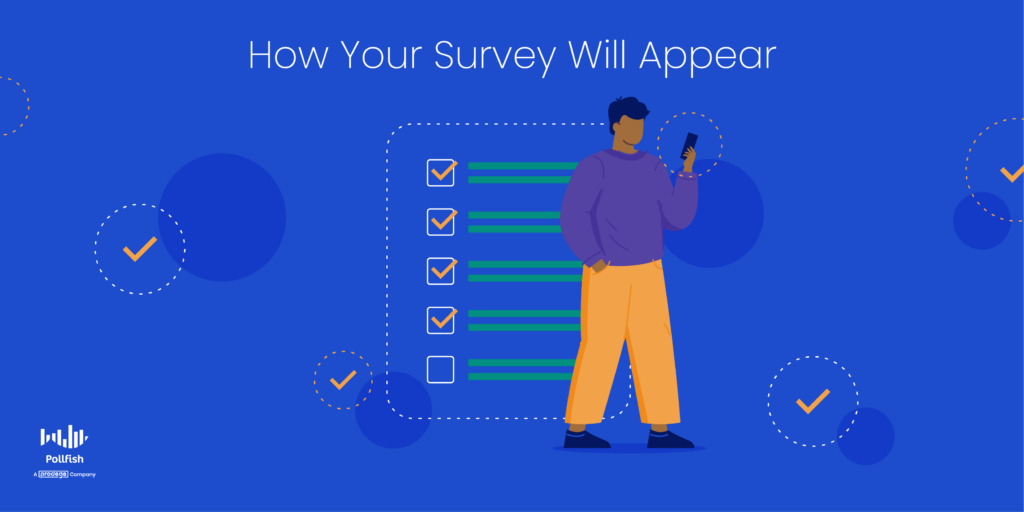
This, of course, differs from what your survey will look like when sent via the Distribution Link method. Here’s what you can expect your survey to look like from both:
Via Random Device Engagement
In different digital spaces, your survey can exist as the following:
- A pop-up
- An image
- A button with a call to action that solely contains your survey. You can take this route if you want to cut to the chase quickly.
- A small, visually appealing circle
- Respondents can see this while in-app.
Via the Distribution Link
When you send your survey to specific places or people, it can exist within the following:
- Your homepage
- A static webpage
- Landing pages
- Blog posts
- Downloadable assets
- Content marketing assets
- Gated content
- Social media channels
- Emails
- Contact pages
- FAQ page
- External websites (when backlinked or via a partnership)
In these spaces, you can insert your survey into your website content or even external websites. The survey itself can take the form of the items mentioned under the above RDE approach.
Where Can I Post Surveys Online?
Finally, we land at the crux of the matter, where can you actually post your surveys online?
While this list is as exhaustive as possible, note that with the expansion of the internet and things like VR and the Internet of Things( IoT), there may be more digital spaces that will become available for survey research in the future.
The prior section (How Will My Survey Appear) touched upon some of the digital spaces we dive into in the section. However, here we provide a thorough illustration of where you can post surveys online.
- Website content
- Use various available pages and elements on your website to place the link to your survey. These include:
- Webpages:
- Homepage
- Landing pages
- Static pages
- Contact page
- FAQ page
- Blog
- Evergreen content places
- Page with gated content
- Video content pages
- Event sign-up pages
- Reports and whitepapers
- Other content assets
- As different web elements
- Page openers
- CTA buttons
- Within the text of long-form content
- Sliders
- Large images
- Below subheadings
- Links within content pages
- Within subheadings
- Social media platforms
- Leverage all your social channels to post your surveys. These include:
- Instagram
- Mention the survey in your bio, a post and in your stories.
- LinkedIn
- Make posts with a link to your survey.
- Twitter
- Make posts showcasing your survey.
- Create polls to quantify interest in taking a survey.
- Reddit
- Create posts, answer questions and create content to motivate people to take your survey.
- Create a unique hashtag for your survey.
- Leverage all your social channels to post your surveys. These include:
- Emails
- Email your survey to the customers that you have contact info on, along with those you don’t have direct email access to. (There are services that provide email addresses, especially business emails, which are ideal for B2B surveys).
- You can use a mass emailing tool such as MailChimp or a CRM platform like Hubspot.
- It’s always useful to add personalization to emails.
- External websites
- Reach out to the editorial departments of popular websites and blogs, especially those relevant to your niche.
- You should also reach out to your own business partners and business customers for collaboration projects that can involve your survey.
- Some may provide backlinks to your site and survey, while others may promote it on their websites. This will depend on your project.
If you're using our Distribution Link feature, it is ultimately up to you to decide where to post your surveys online.
Establishing Strong Survey Campaigns
Whether you’re a veteran researcher or a newcomer to research, you can create informative survey campaigns, the kinds that will give you an in-depth understanding of your customers and other research subjects.
You just need the right online survey platform to do so.
A worthy survey platform will grant you all the functionalities necessary to build a good survey campaign, one that draws in interest and gets respondents to complete the survey.
Pollfish survey software allows you to create a thorough survey data collection, one you can customize to your liking, view however you please and organize to the max.
In addition, with our vast array of question types, you can create virtually any type of survey to aid your research campaigns.
Researchers can leverage a wide breadth of information on their respondents by accessing a wide pool of insights in their survey results dashboard.
In addition, we also offer the advanced skip logic feature, which routes respondents to relevant follow-up questions based on their answer to a previous question.
With the Pollfish market research platform, you’ll never be left wondering where you can post surveys online, as our RDE method posts surveys everywhere.
How to Advertise a Survey to Maximize Campaign Awareness Via 6 Key Methods
How to Advertise a Survey to Maximize Campaign Awareness Via 6 Key Methods
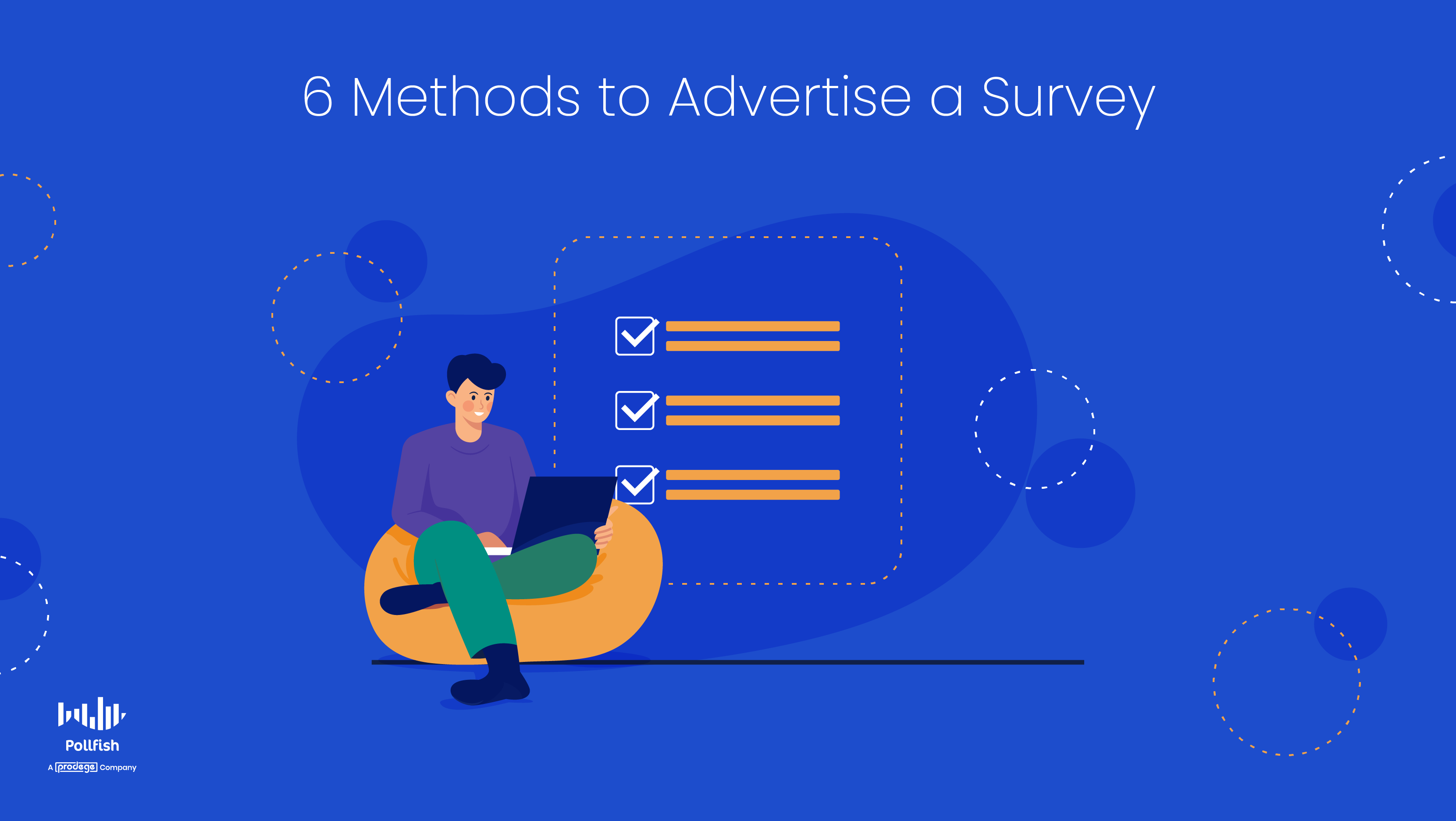
You may be pondering how to advertise a survey to attract as many respondents to your survey studies as possible. After all, you’ll ideally need to reach a sizable number of people in your target market for validity.
While targeting your survey and setting up a strong questionnaire are important aspects of the survey process, reaching an audience and distributing your survey is equally important.
Advertising your survey allows you to do just that, as it is a major step towards luring in your survey target audience. This is critical, given that a significant amount of customers hate taking surveys, leading businesses to lose faith in the power of survey research.
But fear not; there are various methods you can deploy to win over survey respondents by way of advertising.
This article guides you through how to advertise a survey with six key methods and all their underpinnings so that you can increase your survey response rates and most importantly, solidify your research with a high survey completion rate.
How to Advertise a Survey
In some respects, advertising a survey is much like advertising a product. Both pursuits involve grabbing your audiences’ attention, enticing them and commanding them to take action.
But in other respects, advertising a survey is a completely different affair; the outcome doesn’t involve customers paying for something in return. Unlike product advertising, the outcome of survey advertising involves your respondents expending more of their time while not shelling out any money.
On the contrary, the outcomes of product advertising, when successful, are customers who grant businesses some of their time and spend their money.
Thus, you’ll find some of the methods for advertising surveys are similar to advertising a product or service, while other methods are completely unalike.
The following sections illustrate the six major ways on how to advertise a survey, along with the many activities associated with each method.
Share Your Survey on Digital Spaces
One of the best ways to advertise a survey is by utilizing the web and its various digital landscapes. This is a multi-pronged approach that does not require relying on just one digital space, such as one website or one mobile app.
When it comes to advertising your survey, think of the world wide web as your playground (more on this in the Rely on a Survey Platform section below).
While it may be challenging, if not nearly impossible to advertise your survey across all the digital spaces you wish, you can still do so on all of your digital properties. This means you should engage in both promoting and hosting your survey across all of your digital properties.
First, consider all the digital real estate your business owns. This involves obvious places, such as your website’s homepage, along with less clear-cut places, such as a static webpage.
Then, plan out how you’re going to present your survey throughout all the digital spaces your business is a part of.

The two main ways to display your survey across the digital space:
At times, your survey will exist as a pop-up, an image, or a button with a call to action that solely contains your survey. You can take this route if you want to cut to the chase quickly.
In other instances, you can insert your survey into your website content or even base a content asset on your survey. In this way, the surveys your business or organization conducts is highly useful for your content marketing strategy.
Where and How to Advertise Your Surveys Across Digital Spaces
Now, let’s explore where (and how) you can advertise a survey across the massive and ever-growing digital landscapes:
- Website content
- Use various available pages and elements on your website to advertise and take your survey. This includes:
- Webpages:
- Homepage
- Landing pages
- Static pages
- Contact page
- FAQ page
- Blog
- Evergreen content places
- Event sign-up pages
- Reports and whitepapers
- Web elements
- Page openers
- CTA buttons
- Within the text of long-form content
- Sliders
- Large images
- Below subheadings
- Links within content pages
- Social Media
- Leverage all your social channels to advertise your surveys. These include:
- Instagram
- Mention the survey in your bio, a post and in your stories.
- LinkedIn
- Make posts and ads showcasing your survey.
- Twitter
- Make posts and ads showcasing your survey.
- Create polls to quantify interest in taking a survey.
- Reddit
- Create posts, answer questions and create carousel and gallery ads for your survey.
- Create a unique hashtag for your survey.
- Leverage all your social channels to advertise your surveys. These include:
- Emails
- Email your survey to your customers, along with those you don’t have direct email access to. (there are services that provide email addresses, especially business emails, which are ideal for B2B surveys).
- You can use a mass emailing tool such as MailChimp or a CRM platform like Hubspot.
- It’s always useful to add personalization to emails.
- 71% of customers say they expect personalization, as such, use personalized emails when promoting your survey.
- External websites
- Reach out to the advertising and editorial departments of popular websites and blogs, especially those relevant to your niche.
- These will provide backlinks to your site and survey, as well as spread its message to digital properties aside from your own.
- You should also reach out to your own business partners and business customers for collaboration projects that you can pitch your survey to.
Advertise a Survey through Advertising Platforms
While there are various means through which you can advertise your survey, sometimes the best place to do so is by advertising it via the “traditional” one. By traditional, we’re still predominantly alluding to digital advertising, but on platforms designed specifically for advertising.
You can deploy survey ads across the internet via specialized services, such as the following:
- Google Adwords
- Ads from Adwords appear on both desktop and mobile devices and when using the display ads, you can target people by device type.
- You can publish ads within apps, browsers, and Google search results.
- Bing Ads
- These ads cost significantly less than Google Adwords advertising.
- They grant you more control over the language, location, and scheduling of your ad campaign.
- Criteo
- This platform provides online display ads via its Commerce Media Platform.
- It shows personalized online display advertisements to customers who have previously visited their advertiser's website.
- AdMob
- AdMob allows users to decide which ads they want to see and to set filters, so that only the ads that are relevant to them are shown.
- This platform is useful for businesses that seek to monetize by showing ads in their mobile app.
- AdColony
- A mobile ad platform that specializes in video ads. It’s typically used with mobile games that display video ads after users complete a certain level.
- Publishers can show video ads during in-app usage.
- Airpush
- This is the second largest mobile ad platform for Android, and is also available for iOS.
- Airpush offers 12 different ad formats, including video ads, push notifications, in-app banners, landing page ads (post-click), interactive experience ads and overlay ads.
- Amazon Ads
- These ads are usually used to promote your Amazon store but can be applied to promoting other things as well.
- Ads on Amazon can also appear as display ads on third-party sites, instead of being solely the search results on the Amazon platform itself.
- AdRoll
- This is known as one of the best ad networks due to its retargeting applications.
- It uses Google and Facebook to track almost all your website visitors to retarget them with ads that incite them to return.
These are great ad platforms, but did you know there’s more to digital advertising than just PPC ads? In addition, not all PPC ads are limited to search engines and external websites.
In the prior section, we mentioned social media as a worthwhile platform for advertising a survey.
That’s because, aside from posting and sharing survey content and links to your survey, you can also post ads to social media networks. Ads get far more engagement than organic posts, and for good reason.
Since you’re paying for them, social media ads get exponentially more exposure, thus bringing your survey to a wider audience.
- Facebook Ads
- LinkedIn Ads
- Instagram Ads
- Twitter Ads
- Pinterest Ads
Perform A/B Testing to Advertise a Survey
Whichever route you take to advertise a survey, you’ll need to assure you have an effective ad, one that viewers won’t just brush aside as a nuisance or ignore.
As such, we suggest that you perform A/B testing on your survey advertisements. Think about it; businesses perform A/B testing and other kinds of testing to certify the effectiveness of their marketing messages, including their ads.
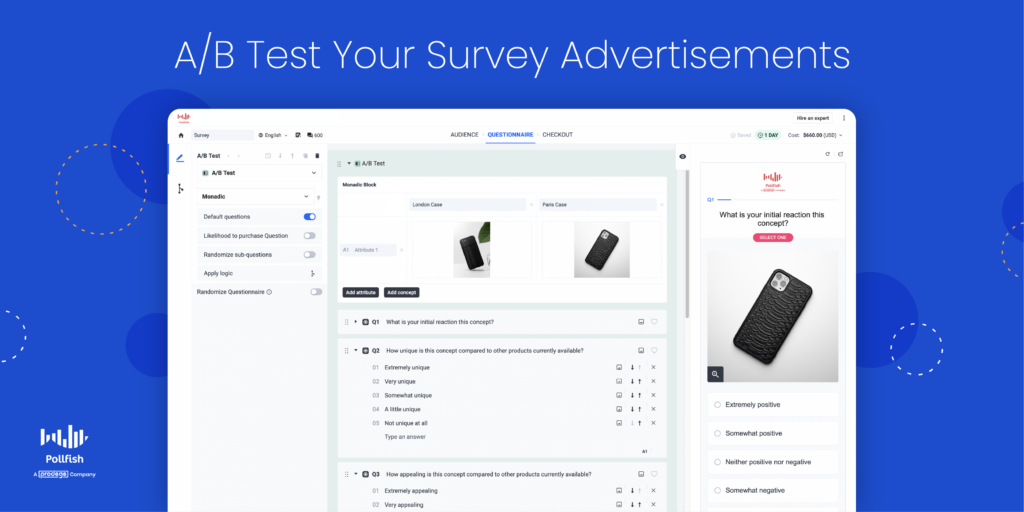
So why stop there? A/B testing ads that lead to or promote your survey is just as beneficial as A/B testing all your other ads and marketing campaigns.
A/B tests are useful for comparing product concepts, communication ideas, as well as survey ads, by way of using equally structured groups of participants.
Use a reputable platform that you can trust to run your A/B testing. You can run A/B tests via Google Ads and other PPC advertising providers. Social media ad providers also allow you to run A/B tests. These include Facebook, LinkedIn and Twitter.
You can even use an online survey platform to create and launch A/B testing. Not every such platform will provide this market research capability.
Luckily, Pollfish provides two types of A/B tests on its market research platform:
- Monadic A/B testing
- Sequential A/B testing
With Monadic A/B testing, your respondents will claim their preferences for one ad or concept that they will get randomly. This ad is just one of the many that the researcher wants to test and compare, instead of being exposed to two or more ads at once.
Focusing A/B test participants’ attention on just one ad at a time provides researchers with a deep dive into making data-backed decisions on specific survey ads.
In sequential A/B testing, researchers can test multiple concepts at once, as opposed to just one with the monadic version.
In this iteration, the A/B testing is also done within one group of questions, yet allows researchers to test more concepts per respondent. This grants researchers added flexibility and efficiency, as only one survey is able to test multiple advertisements for your survey.
Offer Survey Incentives
Another strong approach to advertising a survey is to reward the participants with survey incentives. These incentives can be both monetary and nonmonetary. You can get creative with your incentives to stand apart from your competitors.
Survey incentives are especially important when your survey clearly mentions or displays your brand. Given that you’re advertising your own survey, which probably exists in your digital properties, it is key to posit your brand in a good light.
After all, your respondents will know which company they are dealing with. Thus, you should consider using incentives to frame your brand in a positive way. Survey incentives will do so, showing your brand to be interactive and generous, along with considerate of the respondents’ time.
If respondents see your brand with your survey and it doesn’t offer incentives, this will lead to a negative impression of your brand, even if your respondents are longtime customers.
Survey incentives are essentially a gesture of giving thanks to the respondents, who have taken the time out of their day to provide you with key data.
Just make sure it is clear that your survey offers incentives at the outset. When dealing with a survey ad, always mention the incentive in your ad!!
If you’re using a PPC ad service and lack character space to mention the survey incentive, mention it in the image of your ad. That way, your respondents will be made aware that your survey offers an incentive, even if you cannot say so in the text of your advertisement.
Bring Referral and Influencer Marketing to the Mix
While there are plenty of ways to advertise your survey yourself, that is, through your brand’s digital properties (and even physical ads), you can always apply outside teamwork to advertise your survey.
As such, another crucial method for advertising a survey is to use external sources, such as referrals, influencers and partner marketing.
Referral marketing
Referral marketing represents the activity of having a customer share a specific referral link with others for others to complete a certain action. In this case, it involves completing a survey.
If the person who the customer referred to clicks the link and completes its desired action, (in this case,) both of them benefit in the form of some sort of prize, bonus or discount.
Brands usually reward their referral marketers with a discount or free product.
Influencer Marketing
Although influencers are typically enlisted when brands want to promote a physical product, they can also be used to advertise your survey.
This form of advertising usually includes social media, as people advertise a product or service on their social media channels in return for money, or free products.
The influencers are the people in a niche with a high social media following and a strong engagement with their posts. Influencers can be internet celebrities, traditional celebrities, along with other people or companies with a high level of influence and knowledge in their niche.
Advertising with influencers entails having the influencers in question promote your survey on their social networks. Essentially, they provide endorsements for people to take your survey.
As opposed to regular, text-based or video advertising, influencer advertising brings a more human side to it. That’s because influencers have followers that look up to them and view them as a trusted source for all things in their field.
As aforesaid, influencers commonly advertise physical goods, but they can promote digital ones as well, assuming that your survey exists in the digital realm.
This is a less-used route to survey advertising, but that makes it more unique and creative.
Partner Marketing
This approach entails two or more businesses that join forces for the purpose of advertising (or broadly speaking, marketing). By advertising your survey with a business partner, or through a partner, you can reach a greater audience.
Gather all the partners in your business network into a document. Consider using one that isn’t also your direct competition. While you can use a direct competitor, you ideally want customers to focus on your survey alone.
Partner marketing campaigns allow your business to collaborate with a supporting business that has a similar target market. When pitching your collaboration for the purpose of advertising a survey, remember to explain why it is mutually beneficial.
Then, work out a plan of which digital channels to use for advertising your survey.
Rely on a Survey Platform to Attract Your Survey Audience
Last but certainly not least, use a potent survey platform to advertise your survey. With such a platform in tow, you won’t have to worry about the specific nuances of your ad.
That’s because a strong market research platform will do all the heavy lifting for you when it comes to attracting respondents to your survey.
First off, a strong survey platform will allow you to buy a survey audience. It will do so by enabling you to set all of the respondent qualifications that you wish, along with quotas and integrating multiple audiences in one survey.
In this way, you’ll only receive completed surveys by the people you target, along with a specific number of completed surveys.
Thus, you won’t have to worry about reaching a high survey completion rate, as the survey platform won’t stop iterating until it gathers the entirety of the required completed survey count.
In addition, a strong online survey platform will send all your surveys to the masses, through an extensive network of publishers. These publishers include popular websites, apps and mobile sites.
With Pollfish, our network includes over 250 million customers worldwide. Our app partner network is composed of 140,000 app partners, in over 160 countries.
Organic Sampling and Random Device Engagement (RDE)
Our platform distributes surveys in a randomized way, to catch people who visit a digital property voluntarily. This is known as organic sampling.
Organic sampling allows you to reach non-professional survey takers and gain a far larger reach than you otherwise would.
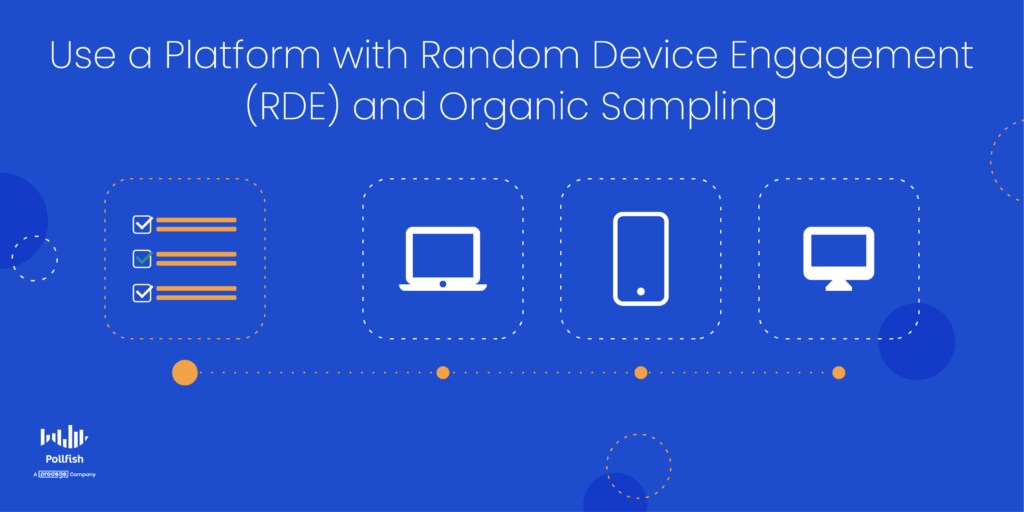 This is because organic sampling involves what’s known as Random Device Engagement (RDE), a kind of survey collecting that relies on advertising networks and other digital portals on devices, to engage random people where they are, voluntarily.
This is because organic sampling involves what’s known as Random Device Engagement (RDE), a kind of survey collecting that relies on advertising networks and other digital portals on devices, to engage random people where they are, voluntarily.
Moreover, in Random Device Engagement, the surveys are delivered to users in their natural digital environments, capturing them where they prefer to be. They were not pre-recruited and thus do not face the same pressures and conditioning that they would in a research panel.
As such, respondents are more likely to answer questions truthfully, as they have no one to answer to, are not pressured to answer in a particular way and are kept anonymous and have got nothing to lose.
All in all, a reliable survey platform provides all the necessary tools to not merely create a survey, but to reach its intended audience. Thus, it essentially removes the need to do any advertising to your surveys.
Getting the Right Audience for Your Survey
Getting the right survey audience isn’t as daunting as it seems, at least not with Pollfish. That’s because Pollfish essentially removes the need to advertise a survey if you send it via our RDE network of publishers.
This survey platform continues deploying surveys until the requisite number of completed surveys is reached. Thus, there’s no need to fret over attracting a certain number of respondents, nor the right respondents, as the platform offers granular respondent targeting.
We want to conclude by stating that a valuable market research platform will offer you all the functionalities necessary for your studies. Thus, that is where your focus should lie when choosing a research platform: its functionalities and the quality of the data.
Our survey software allows you to establish a thorough survey data collection, one you can customize as you see fit, view however you please and organize to the maximum.
In addition, with our vast array of question types, you can create any survey type to aid any research campaign.
Researchers can reap a wide breadth of information on their respondents and access a wide pool of insights in their survey results dashboard.
In addition, there’s the advanced skip logic feature, which routes respondents to relevant follow-up questions based on their previous answers.
With a research platform offering all of these capabilities, it’s clear that Pollfish is the best survey provider that mitigates the need to advertise a survey.
Understanding and Using a Survey Distribution Service for all Your Research Needs
Understanding and Using a Survey Distribution Service for all Your Research Needs
A survey distribution service is a necessity for all surveys — whether they're of the snail mail, telephone or digital variety.
Given that American internet usage keeps rising, with an increase of 8.4 million new internet users between 2021-2022, it is of little surprise that online survey usage has also risen.
Moreover, it’s not just businesses that can benefit from surveys, as educational institutions, research firms and even editorial sites can all reap critical data on their target audience with survey research.
More online surveys are also in keeping with the fact that internet usage is steadily growing globally as well, with an annual rate of 3.7%. Thus, brands can easily conduct global market research, with the right distribution method, that is.
This article explores all that a survey distribution service entails, its importance, its types and more.
Understanding What a Survey Distribution Service Is
As its name suggests, a survey distribution service is any type of service that administers surveys to their intended audiences.
Essentially, this kind of service is tasked with getting a survey from point A to point B, with Point A representing the creators of the survey and Point B the recipients. But there’s much more to survey distribution, as it is not solely a delivery service.
Instead, such a service should do the following to complete your survey process:
- Identify your survey audience.
- This will depend on the survey provider you use.
- In an online survey platform, your dashboard, specifically the audience section allows you to set in your audience qualifications.
- Reach your target audience.
- For business purposes, this is going to be your target market — the group of people most likely to buy from your business.
- Reaching the right respondents is at the heart of distributing surveys.
- Prompt potential respondents to take the survey.
- Prompting your respondents to take your survey includes first getting their demographic and psychographics data should they opt-in.
- In this way, you determine if they’re qualified to take your survey.
- It’s key to make a good first impression, along with designing a strong survey so that you encourage respondents to complete the survey.
- Continue iterating until all respondent quotas are reached.
- With an online survey campaign, you should be able to set the exact number of completed surveys in each survey campaign.
- This includes setting quotas on your respondents.
- For example, you may seek to gain 300 men and 300 women to take your survey, while getting a particular number of respondents that fall under certain categories like income or ethnicity.
- Iterating until reaching completion is what agile market research is all about.
- Save and organize all the data collected.
- It is key to save and organize all the data that your survey collected so that it can be easily accessible to you, the researcher.
- Organizing the data involves granting it accurate percentages and stats, along with presenting it in various formats such as tables, charts and graphs.
- In addition, organizing the survey data involves allowing researchers to filter data as they please.
- For example, the researchers should see post-survey results by filtering them by respondent location, age, ethnic group and all other qualifications.
- This provides them a granular analysis of which respondents answer in which particular way.
As you can see, this kind of service is bent on more than just deploying surveys, since you want them to be taken by the right people and get a particular number of participants.
Thus, you can have different types of providers and use different methods of survey deployment.
The Importance of a Survey Distribution Service
The previous section delves into all the capabilities that such a service should provide, proving its importance.
But if you aren’t convinced of the need to use a strong survey distribution provider, here’s more about its importance.
As mentioned in the introduction, online survey usage is naturally growing with the growth in global and domestic internet usage. Thus, it is critical to reach the correct audience and do so in a timely manner.
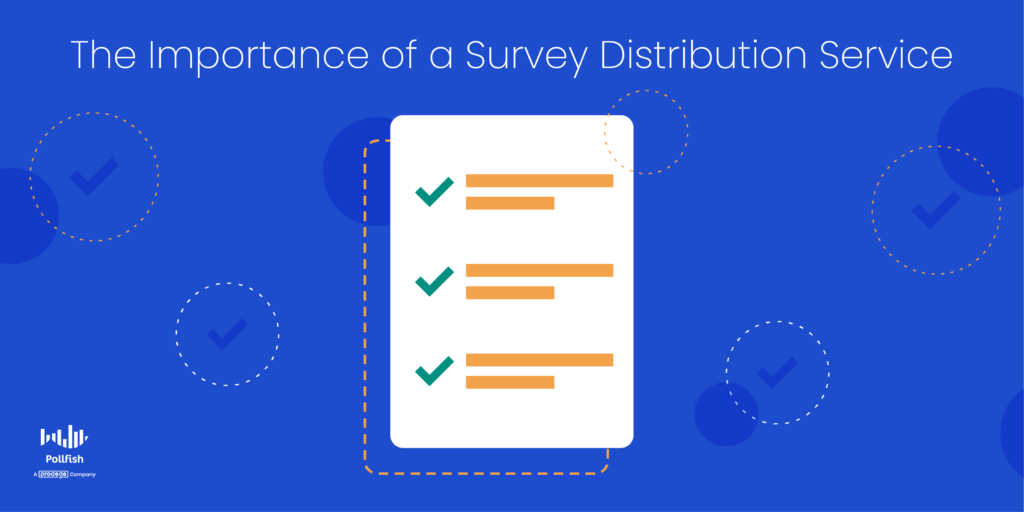
A worthwhile survey distribution model and service remove this task from the researchers, freeing them of what otherwise would have been a major burden. It would be implausible to reach all your designated respondents via snail mail or over the phone if you don’t have their contact information.
That’s why you need to instead use an online survey platform. Added to this need is the aforesaid fact of the growing worldwide group of internet users. Luckily, the online survey software industry has been growing in the past five years, keeping up with the widening pool of netizens.
With a potent distribution service, you can distribute a survey to virtually anyone, which includes anyone in the world. Thus, you can easily partake in global research, all you need is a strong provider to deploy global surveys.
A quality survey distribution service also makes it far easier to study anyone in your target market, along with its various subgroups and customer personas.
Because of this, you can easily set up a target market analysis, as you can rest assured that the number of completed surveys you preset will be reached. In addition, given that this service also organizes all the survey data, you won’t have to go out of your way to make it neatly presentable; the service takes care of this.
Best of all, a strong distribution service ensures all the data you receive is accurate, error-free and fraud-free. That’s because a strong provider will perform quality checks to ensure you’re not getting gibberish answers, VPN users and other undesirable data.
Just keep in mind that not every survey service provides this feature. It is obviously in your best interest to seek a service that performs continuous quality checks, so your data is representative of your audience and doesn’t result in low-quality answers.
All in all, this kind of survey service is invaluable to your market research and virtually all types of research needs.
But equally as important as having a survey distribution service is the kind of provider and survey deployment method you choose, which brings us to the next section.
Main Types of a Survey Distribution Service
There are all kinds of ways to distribute your survey. When it comes to how you choose to do so, there are various service providers. Each takes a different approach to distribute your surveys to their rightful target audiences.
The Main Types of Survey Distribution Service Providers
First, let’s explore the main provider types for distributing a survey:
- Syndicated research:
- Syndicated research is predicated on using a research firm that conducts the entirety of the survey campaigns.
- The firm, therefore, owns all the resultant data and can sell it to interested parties.
- This kind of survey distribution method is generally industry-specific and is therefore funded by several companies within a particular industry.
- While you can buy this survey data, the firm and its partnering companies wield full control over the direction of the survey study.
- Custom research:
- This is a kind of research conducted by and for one company — the client, aka, the researchers, who own the resulting data.

- Market research companies, such as online survey platforms are the providers of this service, offering the data distribution, which clients can customize.
- The client that uses the market research platform has full control of the survey data and the entire campaign, controlling the respondent qualifications of the survey, the questionnaire, the quotas and all else.
- A survey platform in particular can be as customizable as the client makes it.
- This is a kind of research conducted by and for one company — the client, aka, the researchers, who own the resulting data.
Both of these provider types will usually use online surveys, however, there are still some telephone and even snail mail providers. Some providers will even use various means to create and distribute surveys.
The Main Types of Survey Distribution Methods
Finally, let’s dive into how exactly survey providers, particularly online survey platforms distribute your survey to the masses. Remember, not all survey platforms are built the same and thus, not all will offer the following survey distribution methods.
Here are the main ways to distribute your survey:
- Random Device Engagement (RDE)
- A kind of organic sampling, Random Device Engagement allows you to distribute surveys to a wide network of randomized internet users.
- RDE reaches and recruits respondents where they naturally frequent in the digital space, yielding voluntary, anonymous and randomized participation.
- It lowers the biases associated with professional panelists, who may be pressured to answer things in a particular way, as they are not anonymous (or there on their own will).
- Panelists are also more subject to survey fatigue, unlike a random user who chances upon your survey.

- It provides you with a mass network of publishers, that is, if you use Pollfish.
- This method can deploy your survey to millions randomly.
- This method works best via random organic sampling and Random Device Engagement (RDE).
- Specific Digital Channels and Respondents
- As opposed to sending surveys to a mass network of randomized users and digital spaces, you can distribute your survey in a more narrow and targeted method.
- You can deploy your survey to specific respondents and/or specific digital channels.
- This requires a link you can drop wherever you please on the internet and to whom you want to send it.
- You’ll need the Distribution link feature, which allows you to distribute your survey to specific people. You can do so by email or via social media.
- In addition, you can send your survey to nonspecific people on specified digital platforms. Thus, in this method, the survey platform you use won’t be in charge of the places your survey will exist.
- You’ll be able to choose where you place your link to your survey. This can be done through various digital channels:
- On the homepage
- Landing pages
- Emails
- Social media
- Newsletters
- Static web pages
- Partner sites
A strong online survey platform will offer both methods of survey distribution. This way, you are not tied to just one way to reach your desired audience. You can choose either or, or mix and match these methods.
This is why it is key to rely on custom research instead of syndicated research, as it ensures that the client company sets all the requirements of a research campaign, chooses the respondent qualifications and can access and filter the resultant data to their liking.
Thus, you have more options and control over your research campaigns when using a custom research platform, especially when using an advanced survey provider.
Make sure to ask about and peruse all the capabilities of your survey provider; this applies to how they distribute their surveys, along with how you can create a questionnaire and all the special features that are on offer.
Easing through all Your Research Campaigns
Distributing your survey is never difficult with a strong survey distribution system. That’s why you ought to look for a platform that offers top-tier survey distribution.
Such a platform would allow you to conduct both types of survey distribution methods. In doing so, it allows you to buy a survey audience. That’s essentially what you can expect from a robust distribution service, an easy means to connect with your target market.
We want to conclude by stating that a valuable market research platform will offer you all the functionalities necessary for your survey studies. You should therefore focus on a survey platform’s functionalities, the quality of the data and its distribution model.
Our survey software allows you to establish a thorough survey data collection, one you can customize as you see fit, view however you want and organize in any manner.
In addition, with our vast array of question types, you can create any survey type to aid any research campaign.
Researchers can reap a wide breadth of information on their respondents and access a wide pool of insights in their survey results dashboard.
In addition, there’s the advanced skip logic feature, which routes respondents to relevant follow-up questions based on their previous answers.
With a research platform offering all of these capabilities, performing market research is not only doable, but it is also easy and enjoyable.
Understanding and Using White Label Market Research
Understanding and Using White Label Market Research
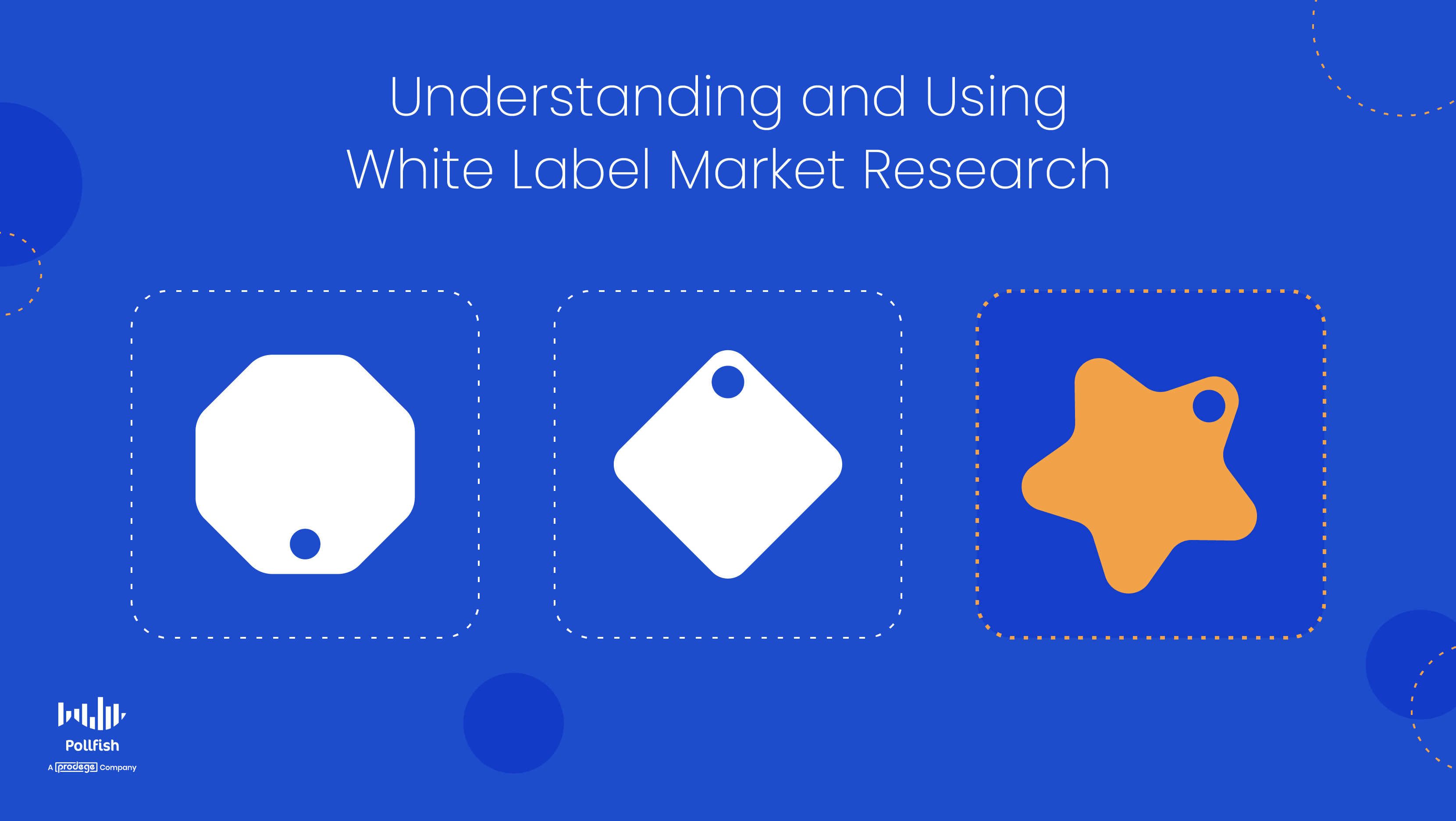
You may have heard of white label services available for a variety of industries, including the ecommerce industry and its various SaaS offshoots. But did you know that it can apply to market research as well?
White label market research can power survey studies, as it exists as a kind of survey model, specifically relating to conducting surveys and the way post-survey data is presented externally.
As we’ve frequently mentioned, surveys are useful for all kinds of endeavors, including boosting your website’s credibility and yours as an industry expert within your space.
But when it comes to white label research and its surveys, is it necessary for strengthening your business? And what exactly is it?
This article explores white label market research, its importance and why you may need it, its pros and cons and whether you truly need it or can opt for an alternative.
Understanding White Label Market Research
To properly nail down the concept of white label market research, first we’ll dive into the meaning behind “white label.”
What is White Label?
White label is a business model in which one company (the manufacturer) produces a product for another company (the buyer). The company that purchases from the manufacturer uses the manufacturer’s products by selling and marketing them under their own name and branding.
This way, the purchasing company makes it appear as though the manufacturer’s products are instead their own, with their own logo, names and other branding elements.
A white label product is therefore often generic and sold to various entities who seek to then brand it as their own.
White label products can already come branded as the buying party’s company, should there have been an arrangement to do so. That’s because some white label providers also sell products with branding services tailored to their purchasing companies’ needs.
What is White label market research?
The same concept of white label and white labeling relates to the encompassing field of technology, specifically to research tech and the field of market research.
As such, in market research, “white label” refers to a company that sells products to another company wherein the buying company takes the seller’s product and rebrands it as its own.
To put it plainly, the company that manufactures and sells the product provides the product and all the work to make it functional, while the client (or purchasing company) sells it as if it were their own.
Specifically in market research, when a company uses a manufacturer’s software to conduct survey research, for example, it will present the research campaign and all of its findings as its own endeavor and itself as the owner of the resultant data.
White label market research, like other white label services, is a form of outsourcing, except you are not outsourcing workers, but software.
Why You May Need White Label Market Research
There are several reasons a business may want to buy from a white label research company. There are also plenty of reasons to go a slightly different route.
First, let’s touch upon the importance of white label research.
Up to 80% of consumers research a company online before visiting it or making a purchase. Thus, having a strong online presence is vital for all brands.
With the rise of businesses going digital and internet-only businesses, there is also a growing demand for white label services.
White label market research can help enhance your online footprint and provide much more.
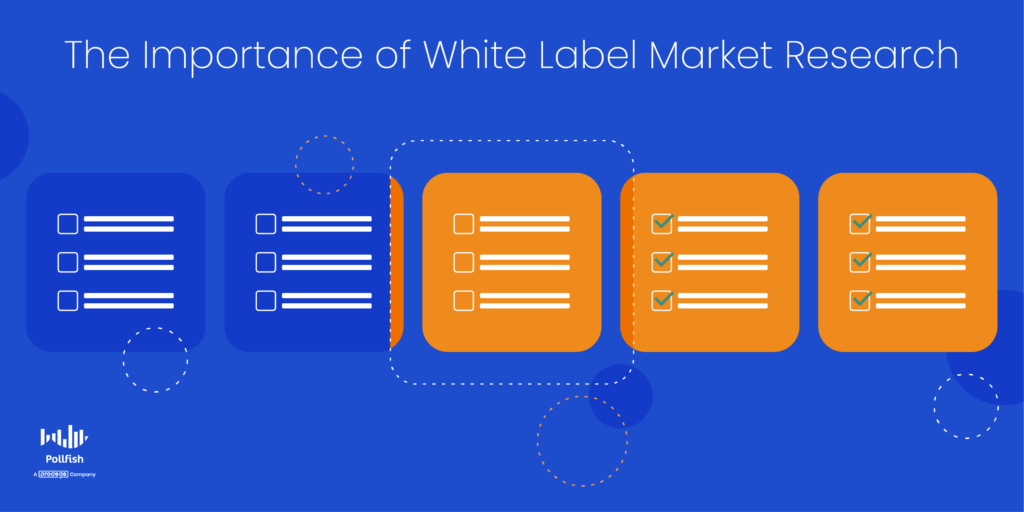
That’s because you can use it as part of your content marketing strategy. When you include original insights and statistics, you’re granting more weight and credibility to any of your online content. You're also positioning yourself as a thought leader in your space.
What’s best is that with primary market research like surveys, the data you provide in your online content, such as your website or social media, is completely yours. At least it is presented as yours with the white label approach.
This shows your digital visitors that your data and content isn’t recycled or secondhand. Instead, it is derived and produced from your brand.
At least, that’s what white label res-tech products will make it appear to look like.
Thus, with white label res-tech products, you can make your business stand out by presenting the research you conduct as your own.
This will make you appear to be knowledgeable, original and a leader in your space. Thus, this will help you both attract and retain your customers at best and attract their attention at the very least.
Meanwhile, the white label company providing you the research platform is doing all the heavy lifting and providing you with its expertise. A strong one, that is.
However, the white label model has both pros and cons, even in the market research space.
The Pros and Cons of White Label Market Research
This form of research has its share of disadvantages and advantages. That’s why it shouldn’t be the sole route you take for market research.
The following lists some of the major drawbacks and positive aspects of using a white label service for your research needs:
The Pros
- Have short lead times.
- Generally easy to work with.
- Often offer a dedicated team of experts to help you.
- All the work is done by the manufacturing company.
- Great for those who have no other research experience or options.
The Cons
- Relinquish all the advantages of associating with another company.
- Not all white label companies make it easy to use your own branding.
- You give up on bringing more buzz to your business (backlinks, awareness, etc)
- Some res-tech companies would have given your research pursuits and business at large a positive reputation. Failing to give them credit deprives you of this benefit.
- You give up on the edge of using a more renowned research company than your competitors.
How Pollfish Fits in with White Label Market Research
The market research res-tech company Pollfish doesn’t neatly fit into or outside of the white label model.
That’s because our survey platform sits somewhere in between or “on the fence” of this approach.
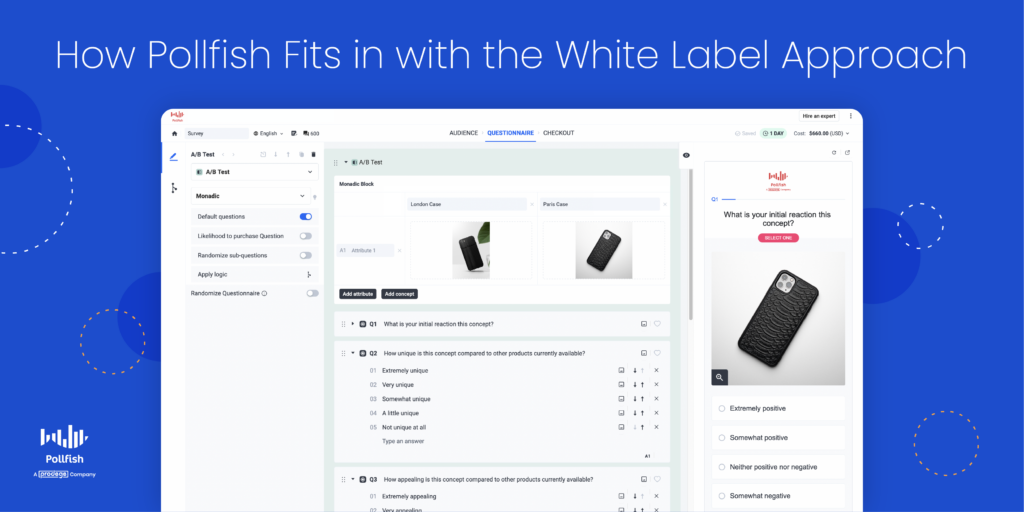
Pollfish provides a diverse suite of market research products under one platform. While we’re generally most known for surveys (a wide range of templates, question types and questionnaire capabilities), we also provide other market research methods and functionalities.
We offer the following market research methods on the Pollfish platform:
- Monadic A/B testing and sequential A/B testing.
- A/B tests can be used to compare product concepts, communication ideas, or specific ads using equally structured groups of participants.
- Maxdiff Analysis
- This is also called the Best-Worst Scale; a Maxdiff Analysis is a means for prioritizing new product ideas and tailoring them to consumer preferences.
- The Van Westendorp Pricing Model
- The Van Westendorp Price Sensitivity Meter is a pricing model that grants you data to make decisions on product pricing, based on consumer price preferences.
- Conjoint Analysis
- A conjoint analysis allows researchers to measure the value that consumers place on various aspects of a product or service.
With Pollfish, most of our clients generally cite us for their research and findings. After all, we’re a well-established company and have become even more so in 2022, after joining forces with Prodege.
In this way, Pollfish is not a white label market research provider.
However, this is not the only way our customers work with us. With customers across business sectors and beyond them (including education, government and editorial), no company uses our platform in the same way.
As such, not all Pollfish clients present their data from Pollfish in the same way. Some businesses that conduct research through the Pollfish platform do not mention us. In this way, some businesses use Pollfish in a rather white label way.
This is especially true with market research agencies; these companies will use Pollfish in an entirely white label manner. They conduct their research campaigns entirely through the Pollfish survey platform but present their studies as completely their own.
This includes the purpose of the study, the targeting, conducting the research and the resulting data.
By keeping us under wraps and presenting themselves as the sole owners and conductors of their survey research, these companies prove that while it is not a traditional white label company, Pollfish can also be white labeled.
All in all, there is a duality in Pollfish when it comes to white labeling. On one hand, we do not market ourselves as a white label platform. We are first and foremost a market research res-tech business.
On the other hand, some brands don’t cite us and present themselves as the sole party involved in their research. Thus, we too can be seen as a kind of white label approach to market research.
The choice is yours on which approach you take with Pollfish. What’s most important is the quality and outcome of your research campaigns.
Mastering Your Research Projects
White labeling your market research can be an effective way to carry out your campaigns and strengthen your brand image.
But it is not the only research approach you should consider. Luckily, the Pollfish research platform isn’t white or black when it comes to this. It fits into a gray area, where although we don’t market ourselves as white label providers, we can be used as such.
Once again, the choice is yours on how you leverage Pollfish. We would recommend mentioning us, however, as we are a renowned market research company that are now working under the even larger research company, Prodege.
We want to conclude by stating that a valuable market research provider will grant you all the functionalities necessary for your studies, whether it is white label or not. Thus, that is where your focus should lie when choosing a research platform: its functionalities and the quality of the data.
Our survey software allows you to establish a thorough survey data collection, one you can customize as you see fit, view however you please and organize to the maximum.
In addition, with our vast array of question types, you can create any survey type to aid any research campaign.
Researchers can reap a wide breadth of information on their respondents and access a wide pool of insights in their survey results dashboard.
In addition, there’s the advanced skip logic feature, which routes respondents to relevant follow-up questions based on their previous answers.
As such, the Pollfish survey platform is optimized for both the respondent and the researcher.
With a research platform offering all of these capabilities, it’s clear that Pollfish is the best market research provider — white label or otherwise.
The Guide on How to Get People to Take Your Survey
The Guide on How to Get People to Take Your Survey
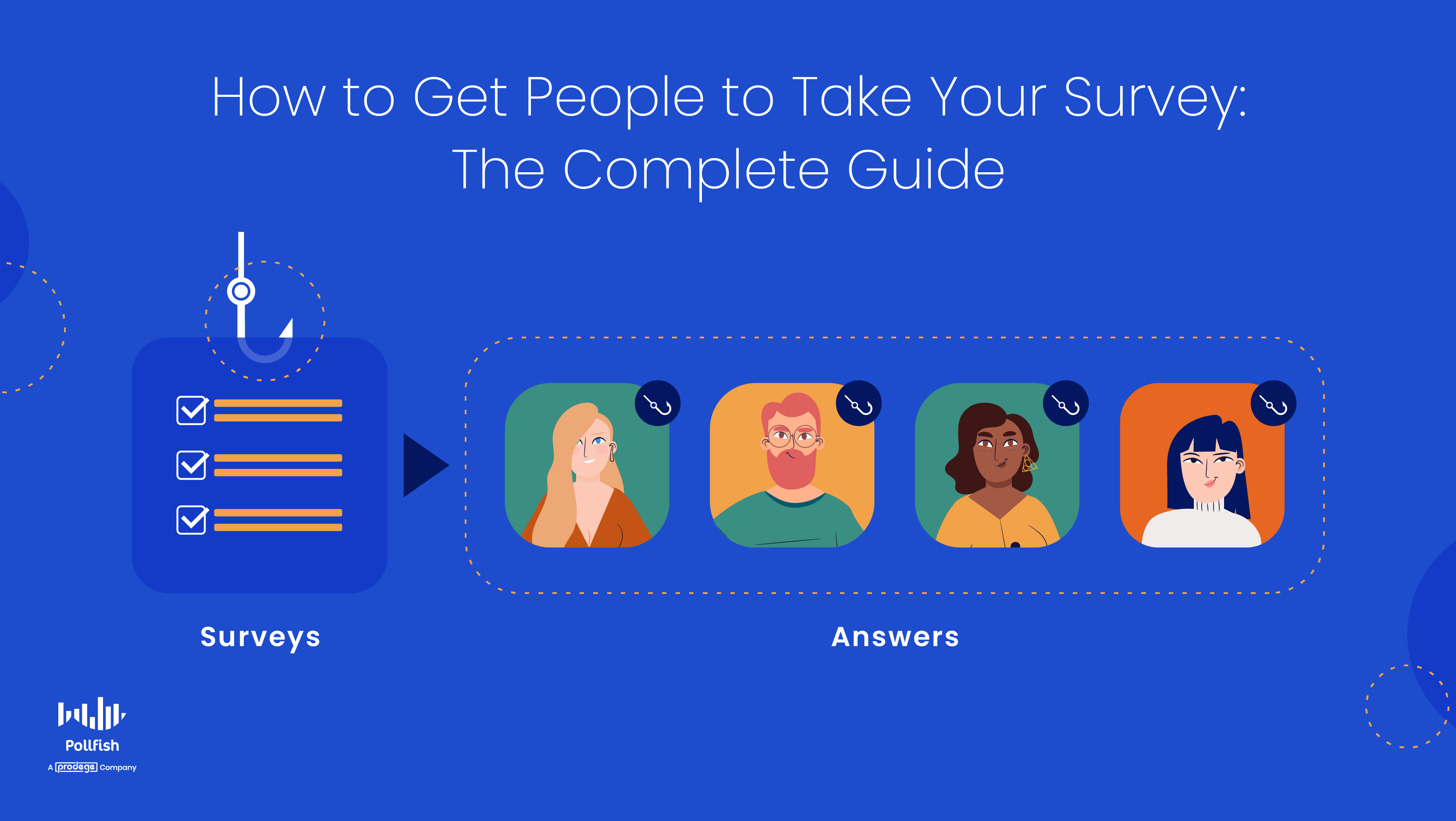
You're in the right place if you’ve ever wondered how to get people to take your survey.
Surveys have become an increasingly vital way to study your target market, as they are no longer obsolete pieces of paper that get snail-mailed and ignored.
Instead, surveys are currently distributed via polling software through an online survey platform (like Pollfish). Such a platform can include various capabilities to fine-tune and optimize your survey, from targeting to deployment, to analysis and beyond.
In addition, surveys are crucial, as they can be deployed at any stage of the customer buying journey. This extends what you can learn about your potential and current customers.
As such, you can study your customers before doing anything, thereby forming your marketing strategy from your survey. You can also survey people after you released a product or completed a campaign.
At any rate, surveys provide an invaluable means for understanding your target market so that you can serve it well and retain your customers.
This article explains how to get people to take your survey at length in the two major methods of survey deployment.
Two Major Ways to Deploy Surveys Digitally
While there are countless ways to send surveys digitally, your survey deployment method is entirely dependent on your online survey platform — unless you send surveys through other means, such as syndicated research.
This form of research isn’t as potent as using a DIY survey platform, since, in syndicated research, the direction of the survey campaign is entirely decided and owned by a research firm. With a DIY platform, you are in full control and have full ownership of your survey results.
With a market research platform, there are usually two main ways you can distribute your surveys:
- A mass network of publishers
- This method can deploy your survey to millions randomly.
- This method works best via random organic sampling and Random Device Engagement (RDE).
- Respondents are reached randomly, where they exist online voluntarily.
- Distribution through chosen digital places / specific people
- This involves sending your surveys or making them available on particular digital properties, often, the ones you choose.
- These digital spaces can include:
- Website home page
- Landing pages
- Static site pages
- Carousels
- Checkout
- After a customer service session (ex: chat)
- Social media pages
- Emails
- Websites you’ve partnered with
- Mobile apps
- With this method, you can reach people randomly, as well as prompt specific people to take your surveys. These can be customers whose contact information you already have.
- This method requires using the Distribution link feature.
How to Get People to Take Your Survey
Now that we’ve established the two major ways to distribute your survey, it’s time to get to the crux of the matter: what you can do to get respondents to take your survey — and complete it.

While it may seem like you need to follow two separate sets of best practices to align with the two key ways of deploying your surveys, you don’t.
That’s because the tricks to get people to take and finish your survey are relatively the same throughout any means of distribution. The same things will continue to irk your respondents, much like the same best practices will quell their irritation and motivate them to complete their surveys.
Thus, you should heed the following advice and incorporate it into all your surveys, regardless if you deploy the surveys across a vast network of random users or send them to specific places or to specific respondents.
By doing so, you’ll get more responses, thereby increasing your survey completion rate and obtaining your responses sooner.
1. Keep your questionnaires short.
No matter how convoluted the topic is, it is always best to keep surveys short.
If you’ve won over respondents to fill out your survey, a feat in itself, don’t sabotage this by creating long-winded questionnaires.
Just because someone agreed to partake in your survey, doesn’t mean they’ll stay. They can drop out at any time they feel overwhelmed by too many questions or as though they are wasting tier time.
Or, they may simply get bored and abandon your survey.
Keeping your surveys short will stave off survey attrition. Ask no more than 10 questions, 15 at most. Any more will require an incentive to partake.
2. Lure respondents in with a strong introduction.
This exists as the first page respondents will see in their survey.It can also take the form of the title or call-out of your survey.
You’ll need to lure in respondents with something that sounds both interesting and easy for them to do.
As aforementioned, no one wants to waste time with lengthy surveys. As such, promise that the survey is short with language such as: “Take a quick, 5-minute survey” or “take a fast 5-question survey.”
This will entice potential respondents of a survey experience that won’t take too much time from them from the get-go.
3. Make your respondents feel special.
You can make respondents feel special by acknowledging the importance and usefulness of their participation.
No one has to take a survey and your respondents know that they are primarily for the benefit of your business.
Remind them of how important their responses are. You can mention the specific purpose of the survey, along with what and who it’s meant to help.
As such, you’ll partially reveal your survey campaign to them, but it’s okay, as you’re not revealing your exact goals. You’re simply going to state why it’s helpful for customers such as themselves.
4. Keep your questions highly relevant.
The advanced skip logic feature, which routes respondents to relevant follow-up questions based on their previous answers is key to this.
This feature directs respondents to different questions, specifically, a question that is most relevant to the respondent, based on the answer they had previously provided. That way, the experience is far more personalized and the questions make more sense.
You wouldn't want to ask a question that contradicts the answer that the respondent provided in a previous question. Not only will this annoy the respondent, but you’ll also be bogged down with data from question that you don’t need.
For example, if you asked if a respondent has heard of a particular brand and they haven’t, it would be irrelevant and useless to follow up with what they like or dislike about the brand in question.
5. Offer survey incentives.
There are a number of incentives you can use to create buy-in from your intended respondents. This is especially important if you’re sending surveys the second major way: to specific places or specific people.
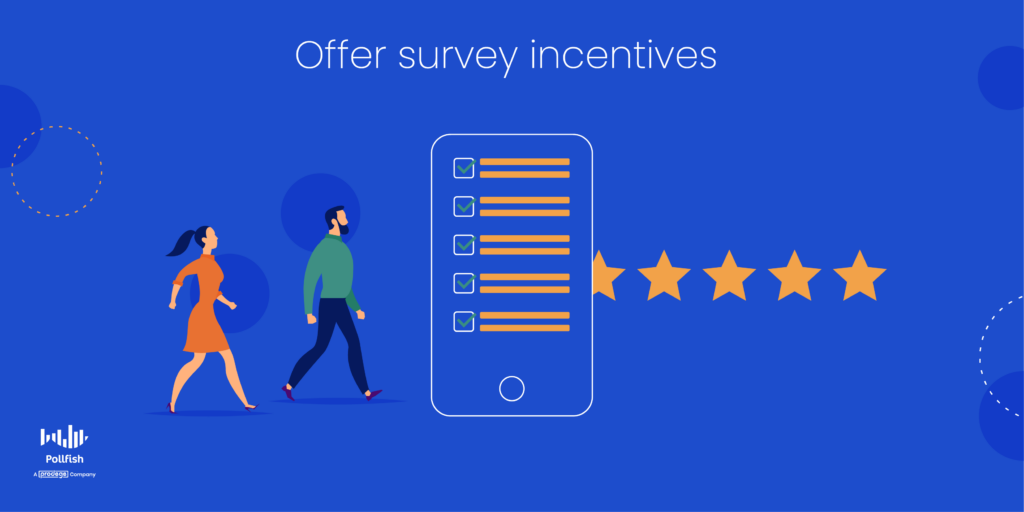
In this case, respondents will know exactly who is reaching out to them. This is true even if they opt-in to take a survey themselves that they’ve found by visiting, say, your social media, (as opposed to you reaching out to them directly). They’ll still know the brand they’re working with.
Thus, it’s even more important to have your survey framed in the best possible light, as your respondents know it’s tied to your business.
A survey incentive will do just this. In addition, incentives are some of the biggest motivators to complete a survey or do virtually anything else. Even if it is a small incentive, it is useful in that respondents know that they’re somehow being rewarded for their participation.
Essentially, they’ll have something that's in it for them rather than simply knowing they’re helping others.
Remember, survey incentives can be monetary and nonmonetary alike.
6. Be mindful when you ask sensitive questions.
Some survey campaigns will deal with sensitive topics, the kind that not everyone is comfortable with sharing.
Most people aren’t willing to discuss private information, especially if it deals with heavy subject matters such as death or loss.
Many people will be hesitant to answer questions that simply mention the aspects of their lives they intend to never share. Thus, be careful in how you ask sensitive questions. Sometimes, you may want to omit them altogether.
Sensitive questions can include questions on the following topics: religion, politics, self-identification, unpopular ideas, illegal or frowned upon behaviors, as well as questions that seem to require socially acceptable responses.
As such, be as reassuring as possible and don’t make judgmental implications or use such a tone.
7. Assure respondents of their privacy.
Whether it’s in the call-out, the introductory page, the title or the thank you page, make sure you guarantee respondents their privacy.
It’s ideal to make this known as early in the survey as possible, because no matter how light-hearted or inconsequential the topic of the survey may seem, users will still want to remain anonymous.
As such, your respondents will be less hesitant to take your survey if they know their privacy is assured right off the bat.
Don’t forget to make your surveys adhere to digital privacy laws!
This cannot be overstated, especially when it comes to the GDPR. Although the GDPR is an EU regulation, it can also apply to the United States and other countries in certain conditions. The GDPR applies to the US when you’re dealing with European netizens.
This means U.S. businesses, nonprofits and universities that target or track the online activity of users in the EU must comply with the GDPR. There are various ways to do this, such as asking for respondent consent, including an opt-out button and using end-to-end encryption.
9. Ensure that all questions are straightforward.
Avoid confusion or questions that involve a lot of deep thought.
That’s why it’s critical to use simple and easy-to-understand language.
This will differ, of course, based on the target audience of the survey. Some audiences understand scientific jargon, some understand technical language, and some are perfectly familiar with literary language.
But not everyone is. Most people don’t care to put much thought into a survey, especially one they are taking for free. Thus, avoid any ambiguity in your questions and assure that they make sense to your target market.
If you need help constructing your survey questions, we offer various survey templates, which you can use for inspiration and edit them to your liking.
10. Make your survey lively and retain interest throughout the process.
This is where you get to flex your creative muscles.
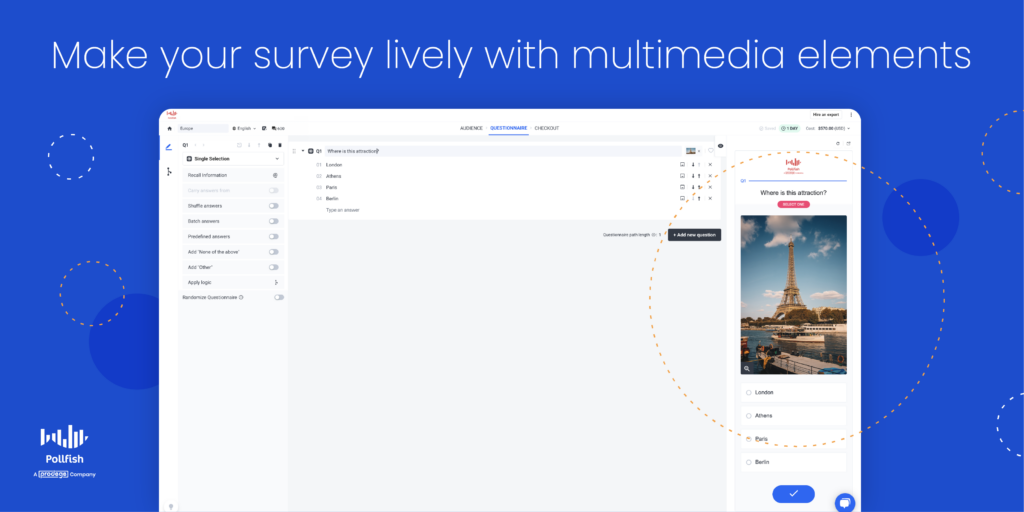
There is no hard and fast rule to make your surveys interesting. However, we suggest doing the following to spruce your surveys up:
- Ask questions that are not just relevant, but presented in a creative way, one that’s not common.
- Depending on the subject matter, use humor to draw out laughter.
- Add text that prompts respondents to continue the surveys. Ex: Ready to take a dive into [a cool ad, keys news of the day, the world of…]
- Use multimedia elements, such as images, GIFs, videos and other files so that your survey isn’t as text-heavy and offers something pleasing to the eye.
- Use a variety of questions (Matrix questions, stars and emoji scales, bipolar questions, drill-down questions and more. This too provides visual appeal and wards off boredom.
As you can see, there are various ways you can make your survey lively and retain respondents’ interest. With a strong online survey question, it should be easy to do all of the above and more.
Remember to mix and match questions. And yes, surveys can be visually appealing too.
11. Provide access to results.
This does not have to be immediate and likely won’t be. After all, you’ll need to have collected all required survey responses before you even have any results to share.
Thus, provide them with the option of having the results sent to them. This can be in the form of a link or asking respondents to share an email address.
The latter is even more useful, in that it gives you access to your customers’ emails. But bear in mind that not everyone will be willing to share their emails.
As such, it’s useful to have a webpage with survey results that you can create before you’ve gathered data. This page should mention that it will be updated with the results, once they are ready.
Doing so will not simply make your survey more appealing to take part in, but it will also build brand trust, a must to retain customers and attract new ones. When it comes to the latter, it’s important to build credibility, as that is key to the onset of your relationship with new customers.
Attracting Everyone in Your Target Market
When it comes to getting people to take your survey, there are various approaches you can take. From simplifying language, to offering different question formats, this can all be executed well with a strong online survey platform.
A valuable survey provider will grant you all the functionalities necessary to build a good survey, one that draws in interest and gets respondents to complete the survey.
Our survey software allows you to establish a thorough survey data collection, one you can customize to your liking, view however you please and organize to the max.
In addition, with our vast array of question types, you can create any survey type to aid any research campaign.
Researchers can reap a wide breadth of information on their respondents and access a wide pool of insights in their survey results dashboard.
In addition, there’s the advanced skip logic feature, which routes respondents to relevant follow-up questions based on their previous answers.
Needless to say, our survey platform is optimized for both the respondent and the researcher. Thus, everybody wins!
With a research platform offering all of these capabilities, you’ll be able to easily lure and retain a survey target audience, one that will work through your surveys until they’re complete.

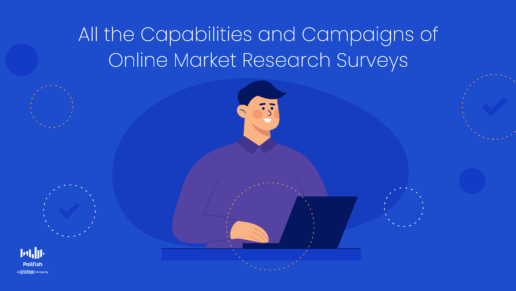



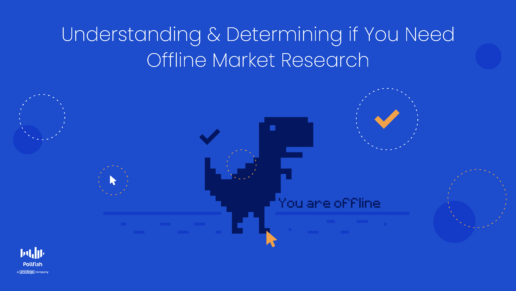



 Create the survey you want
Create the survey you want 








